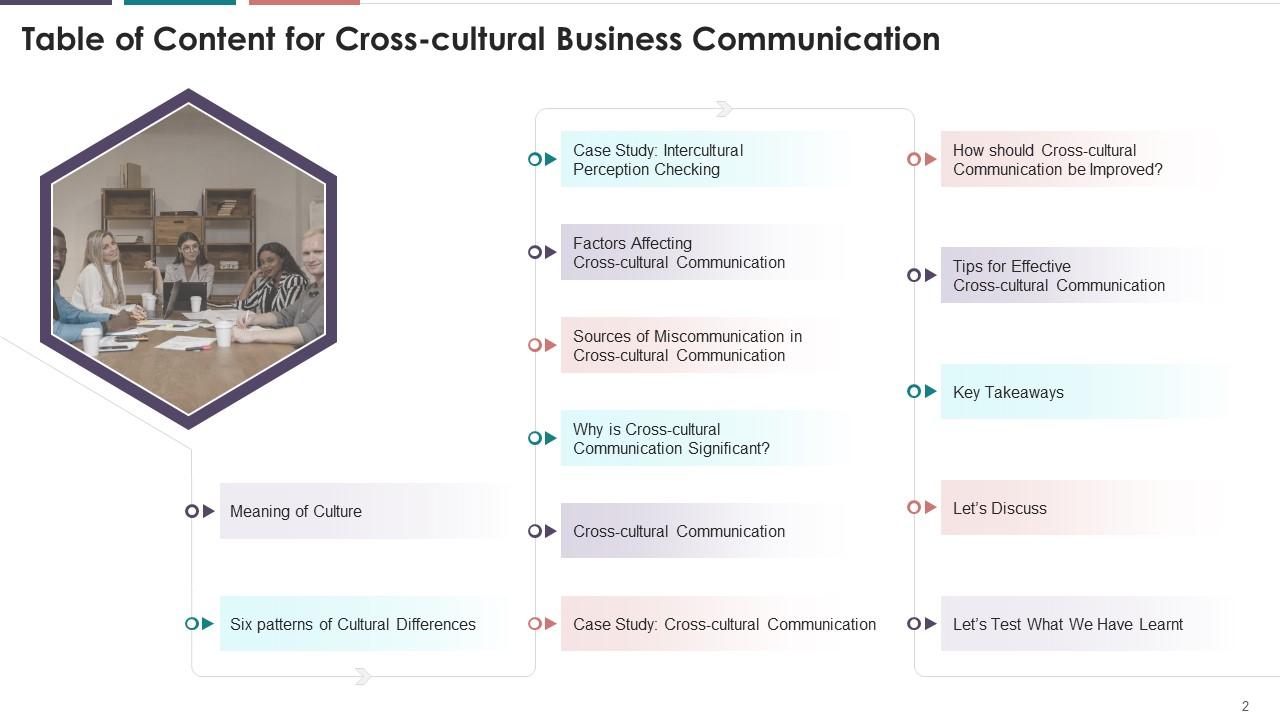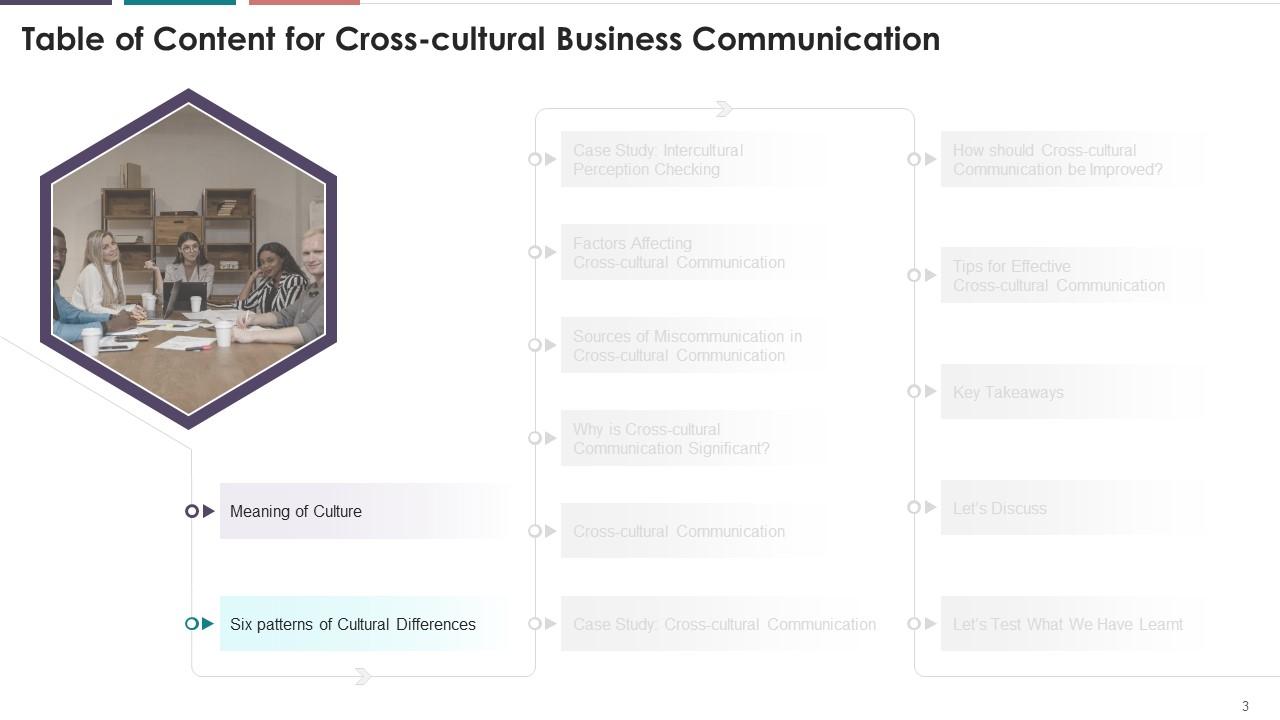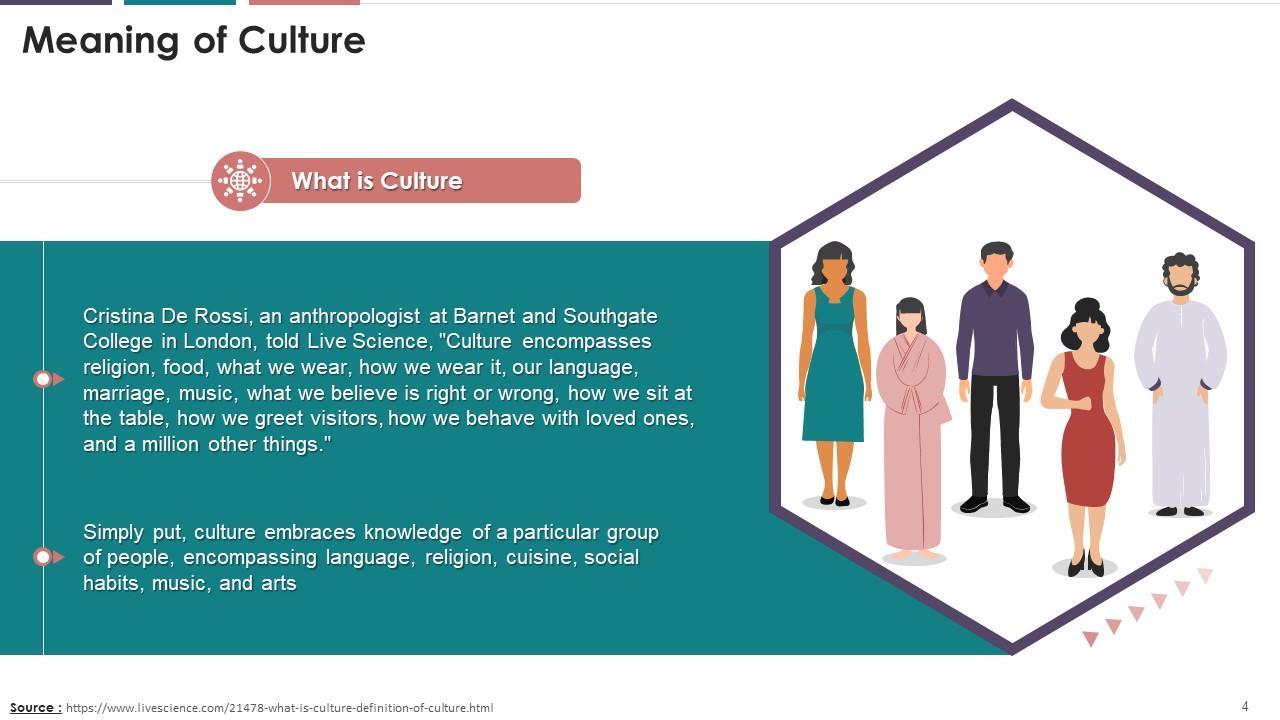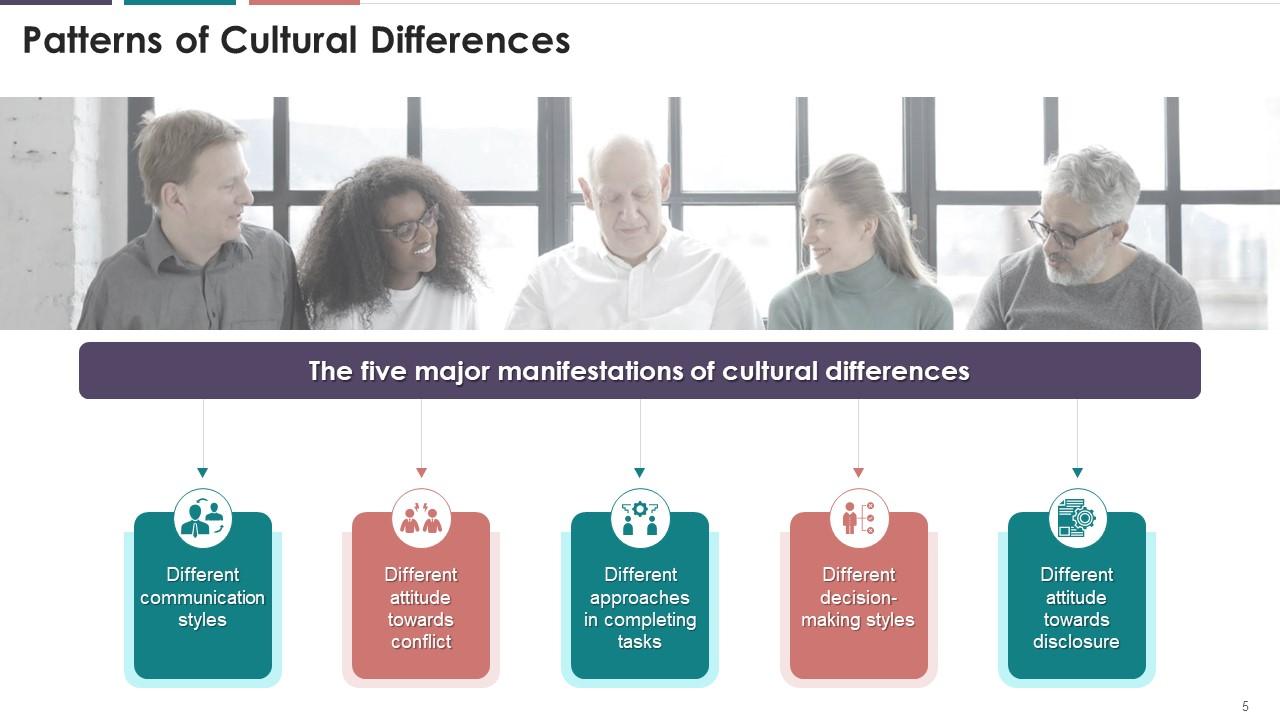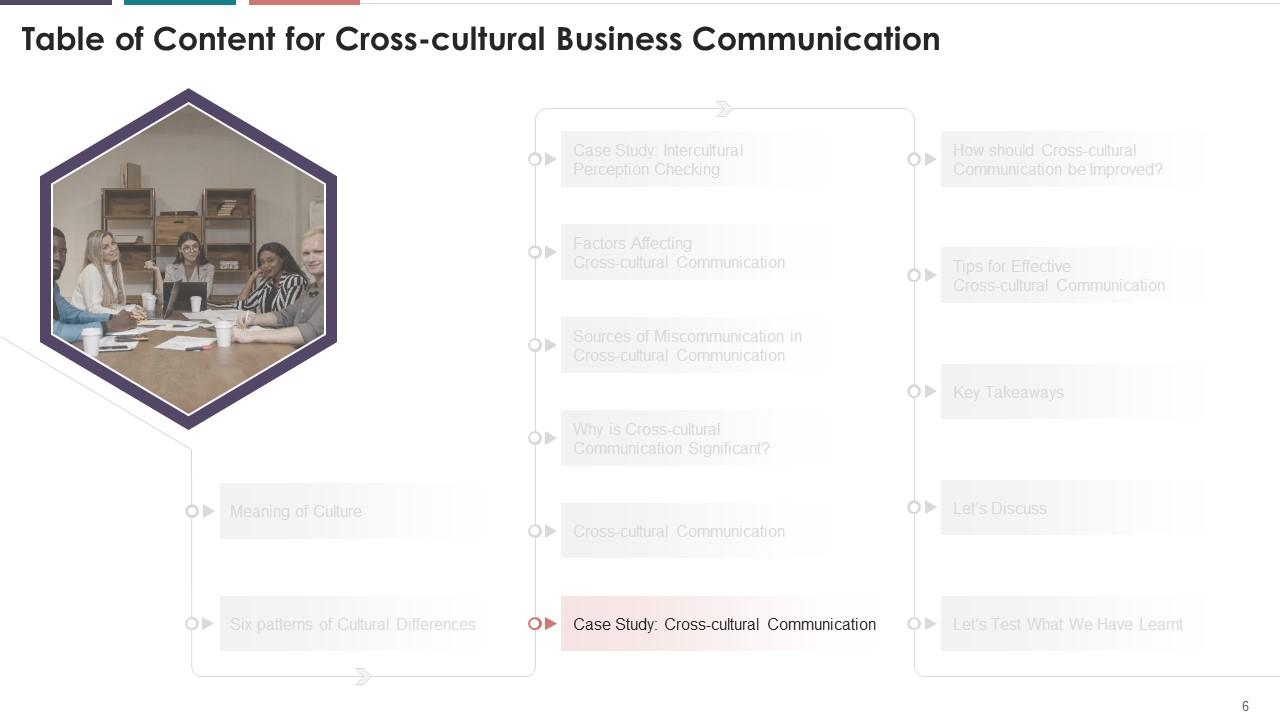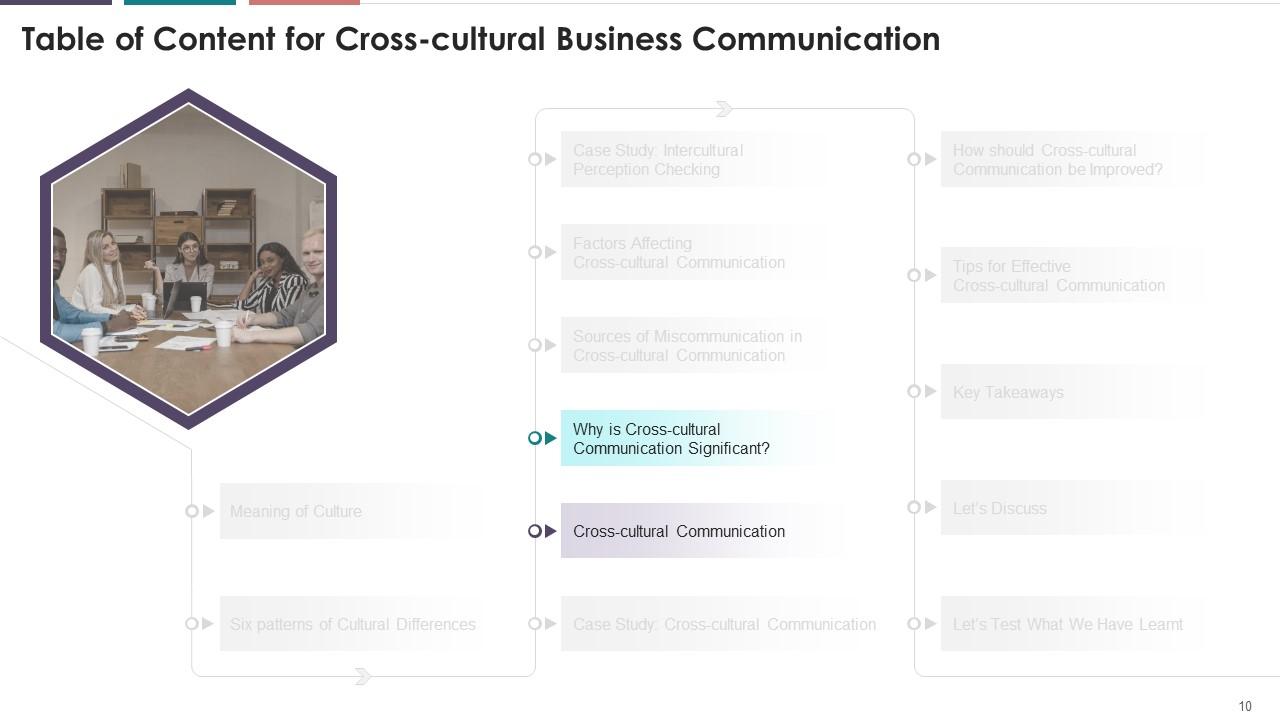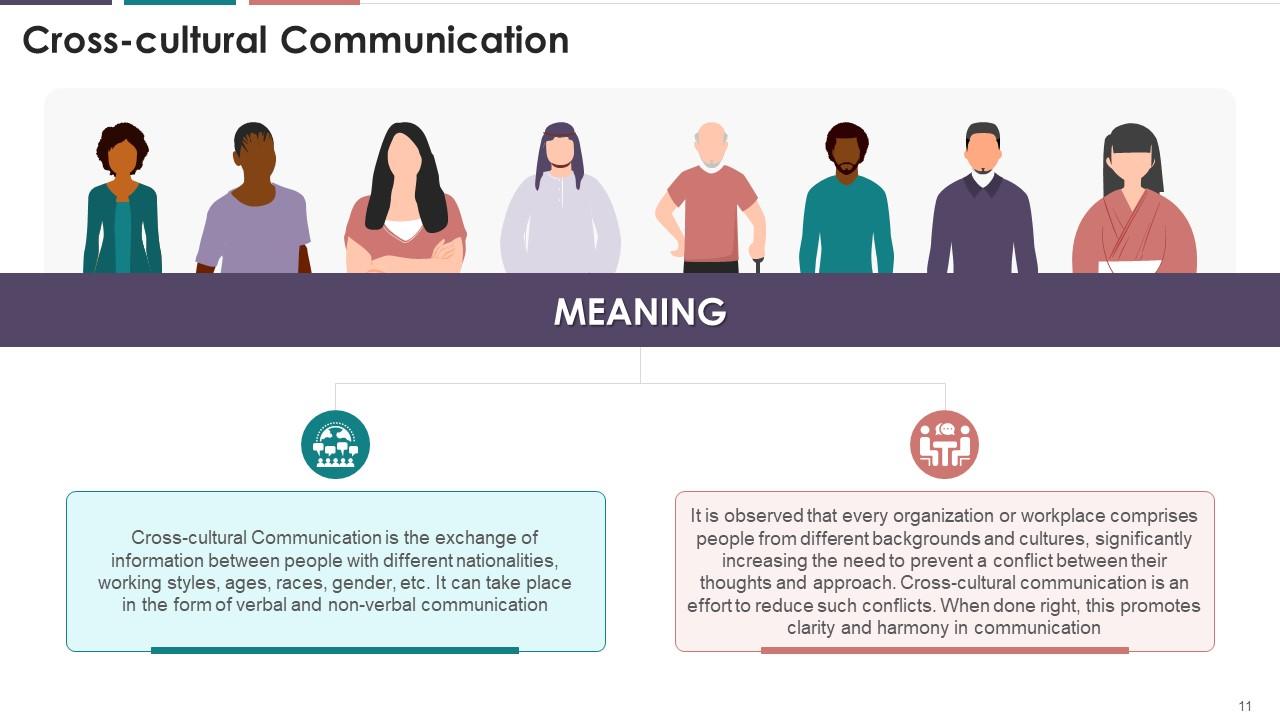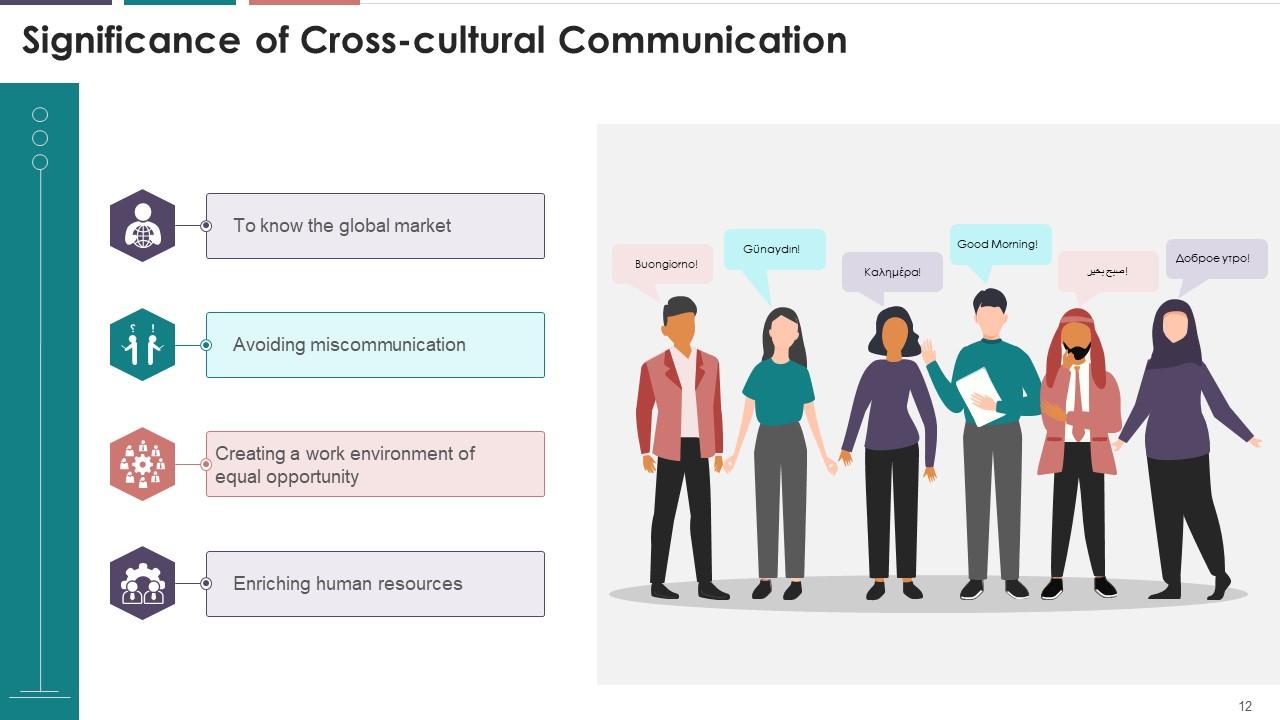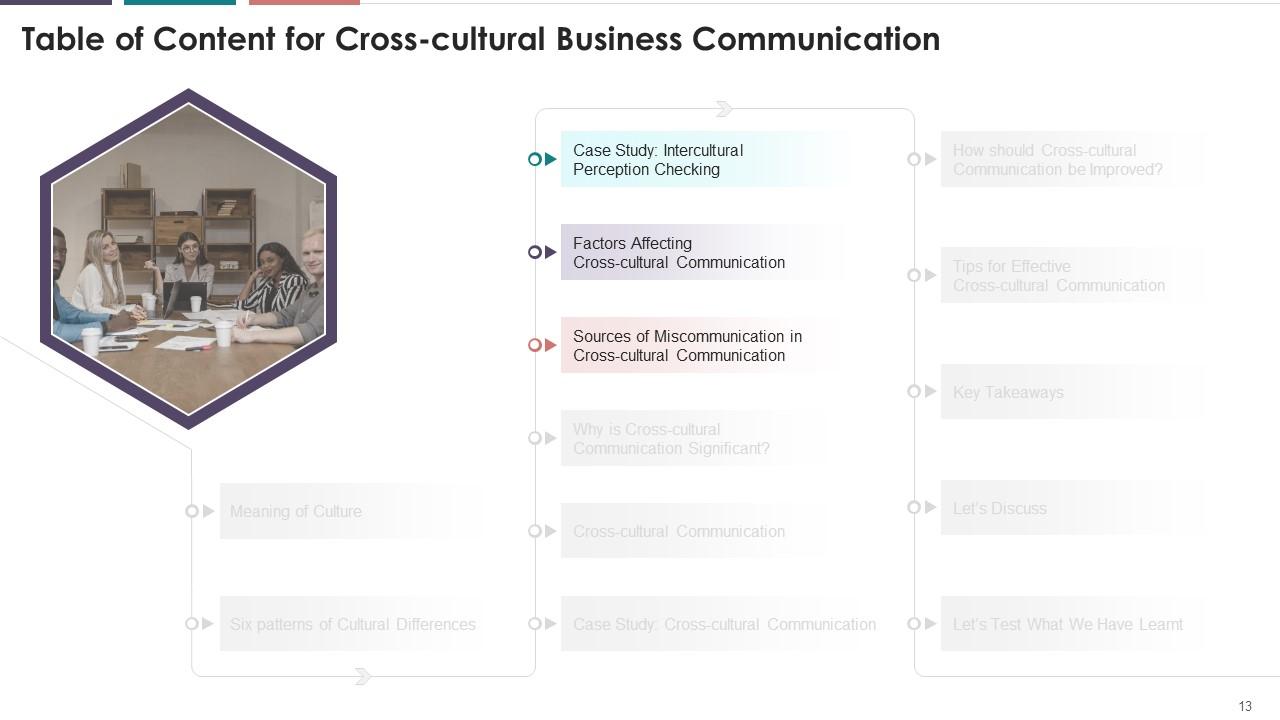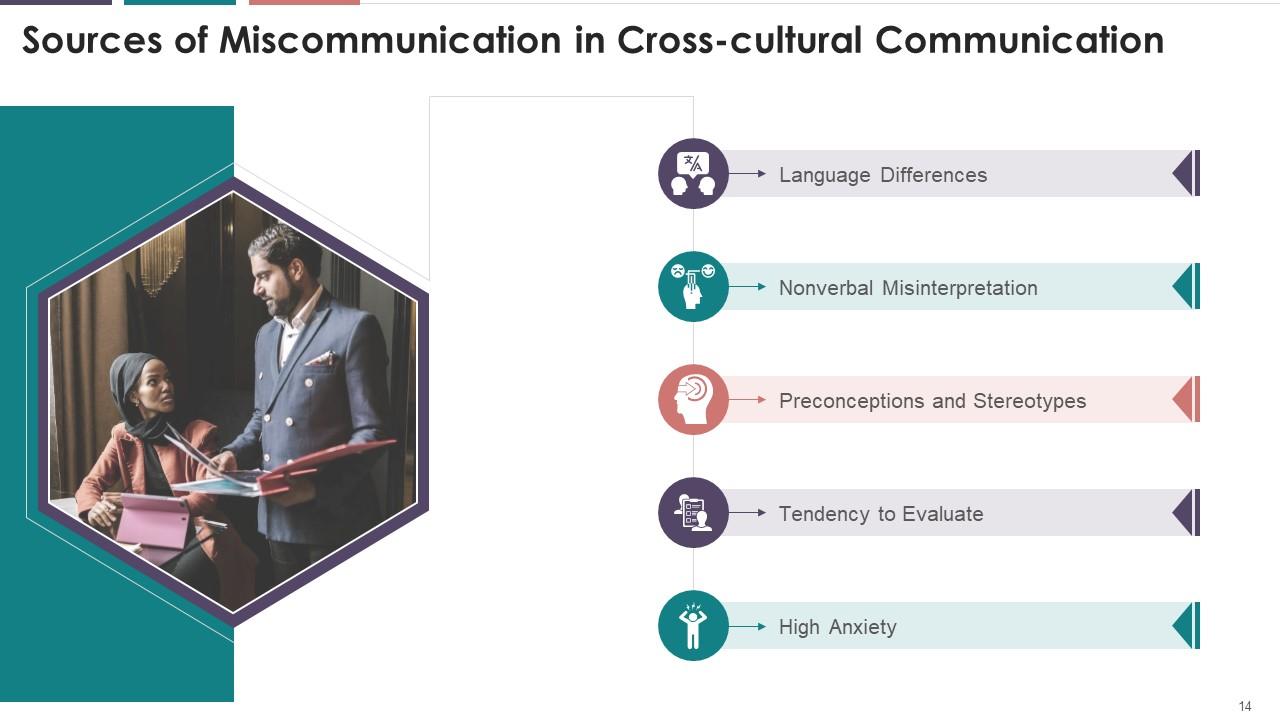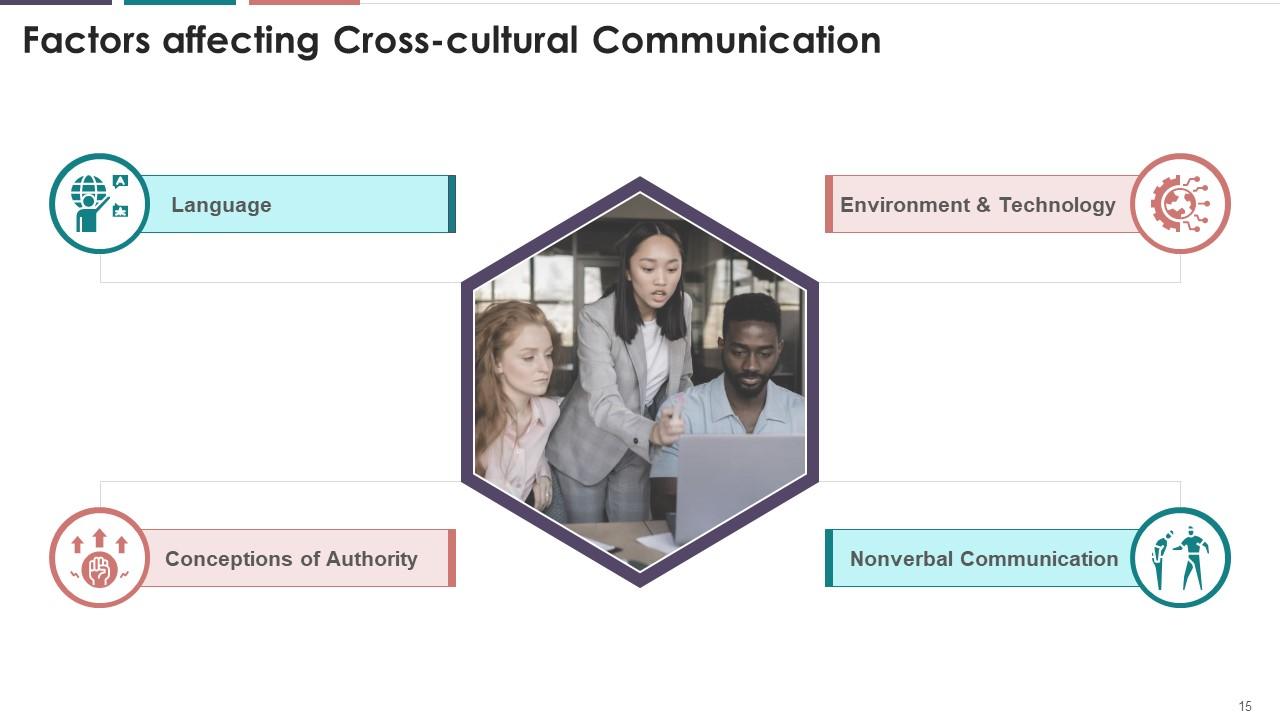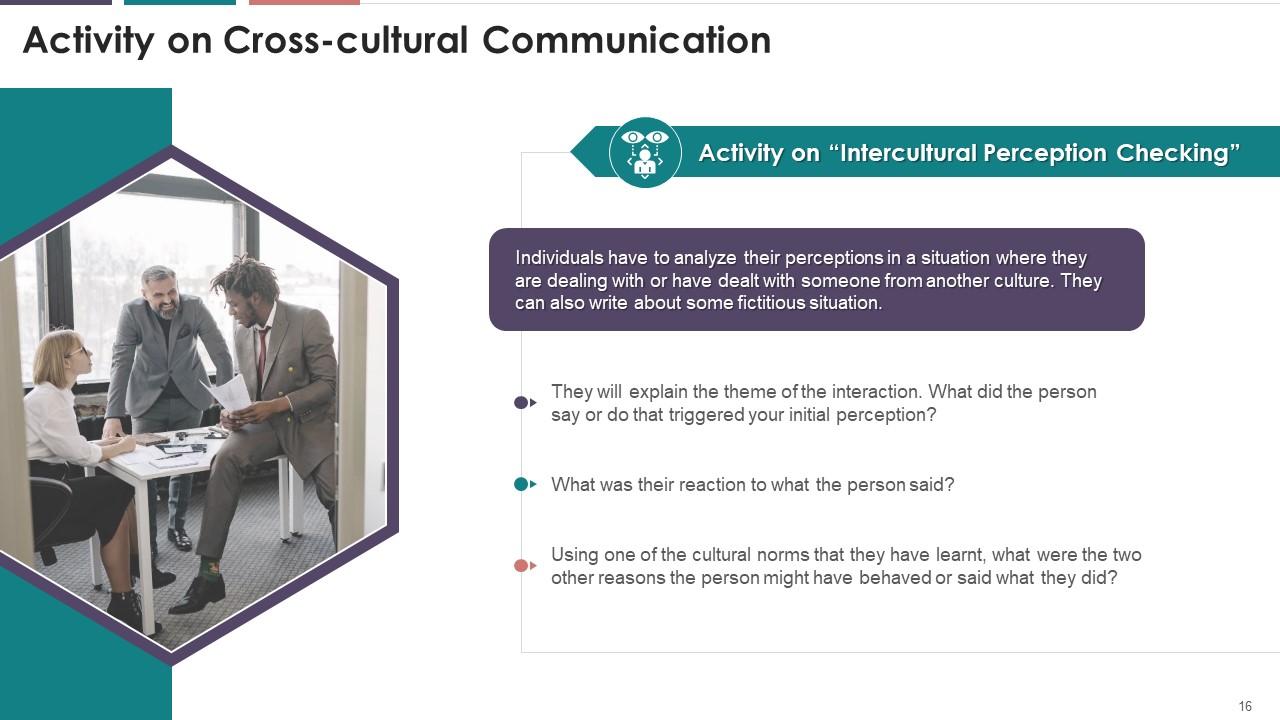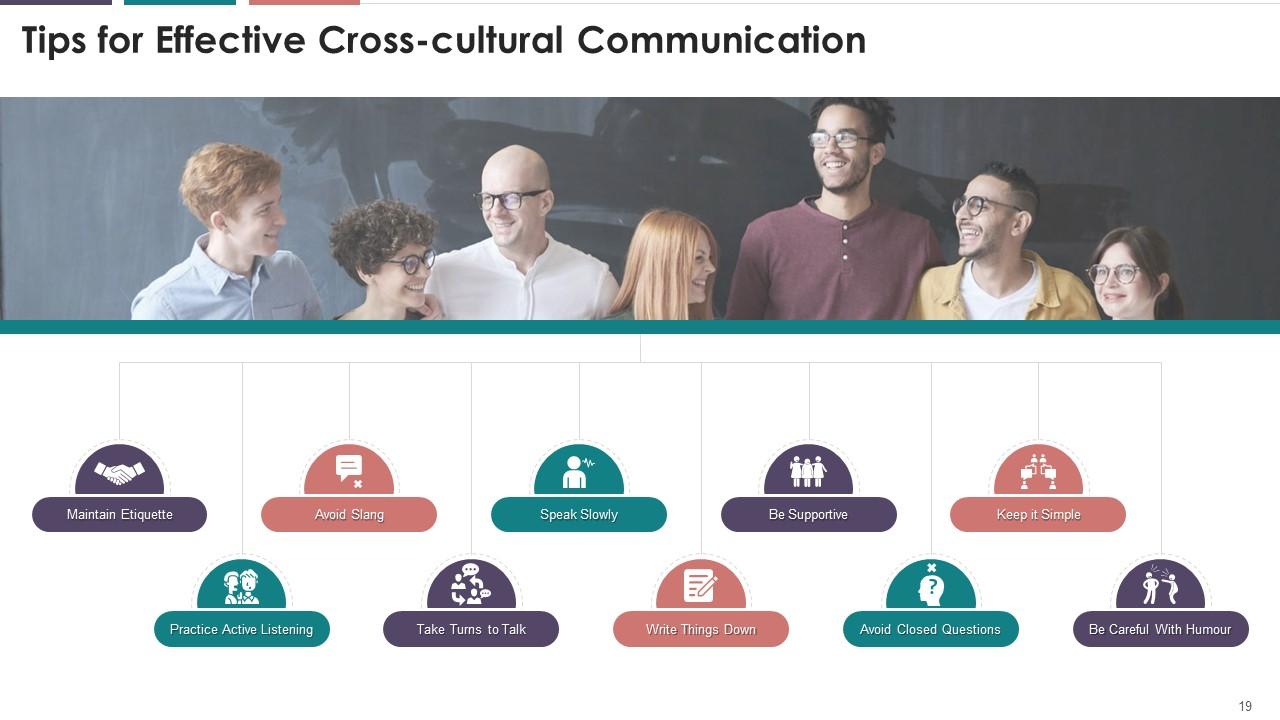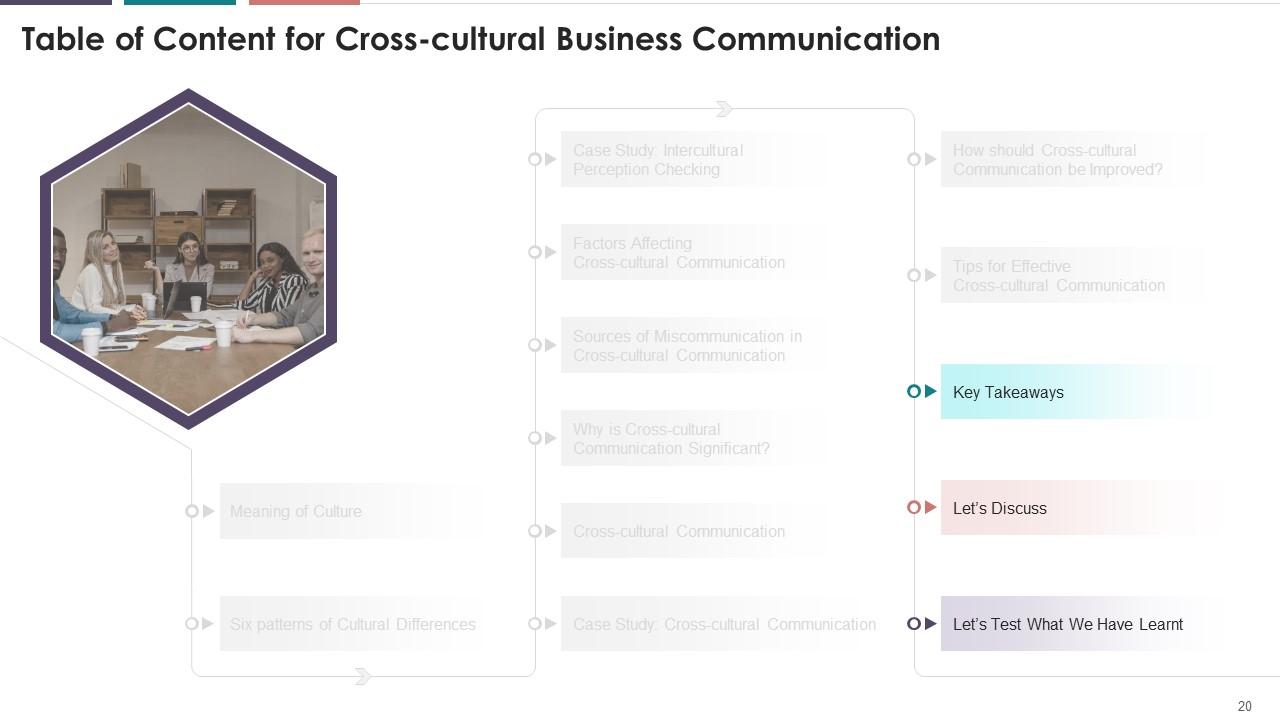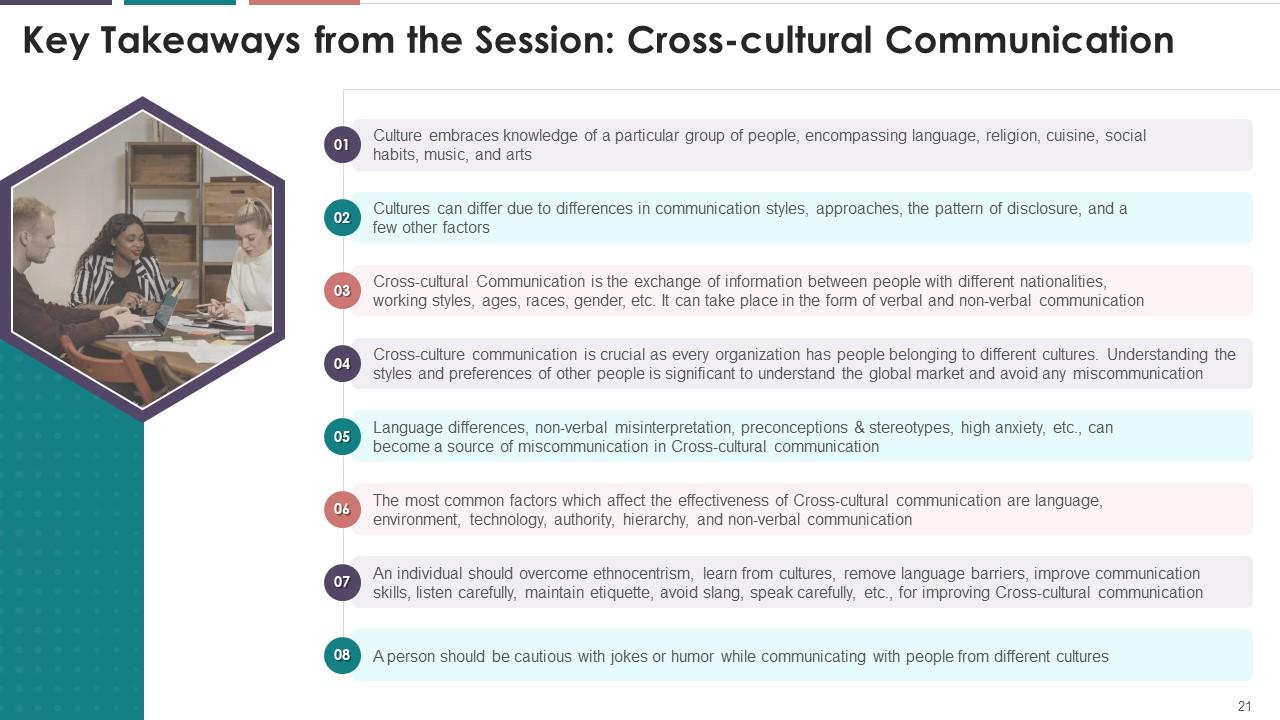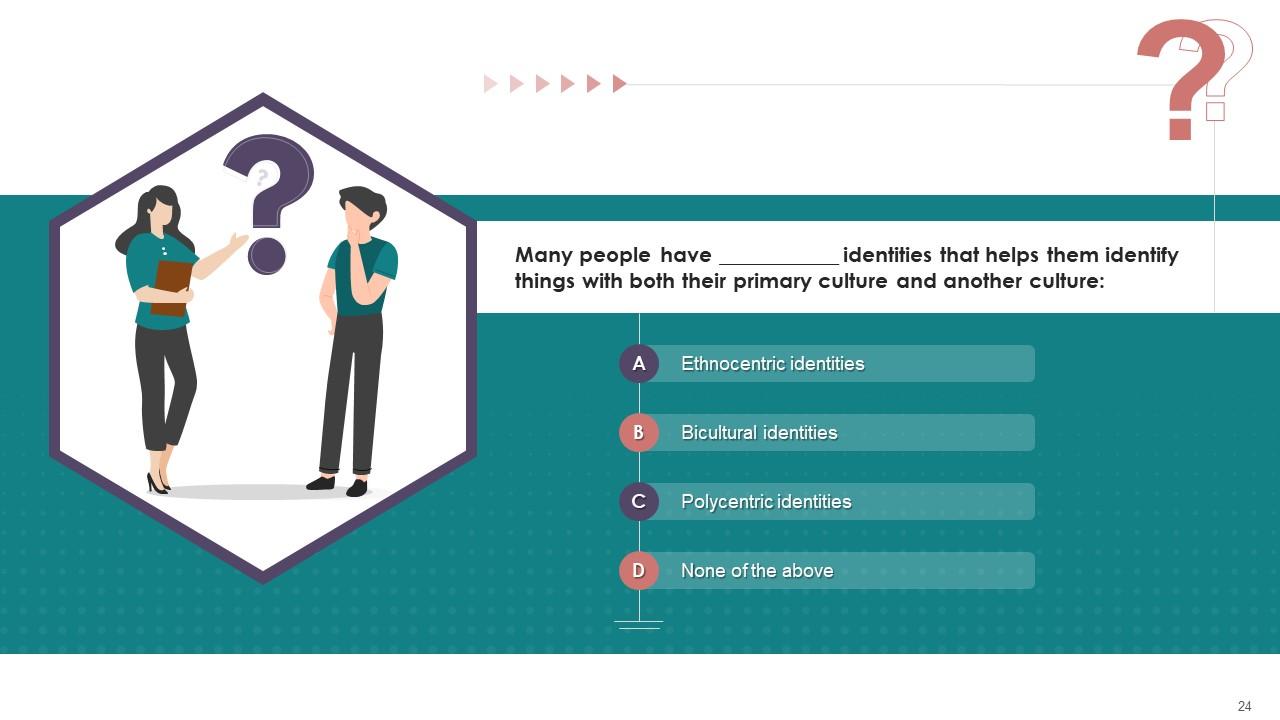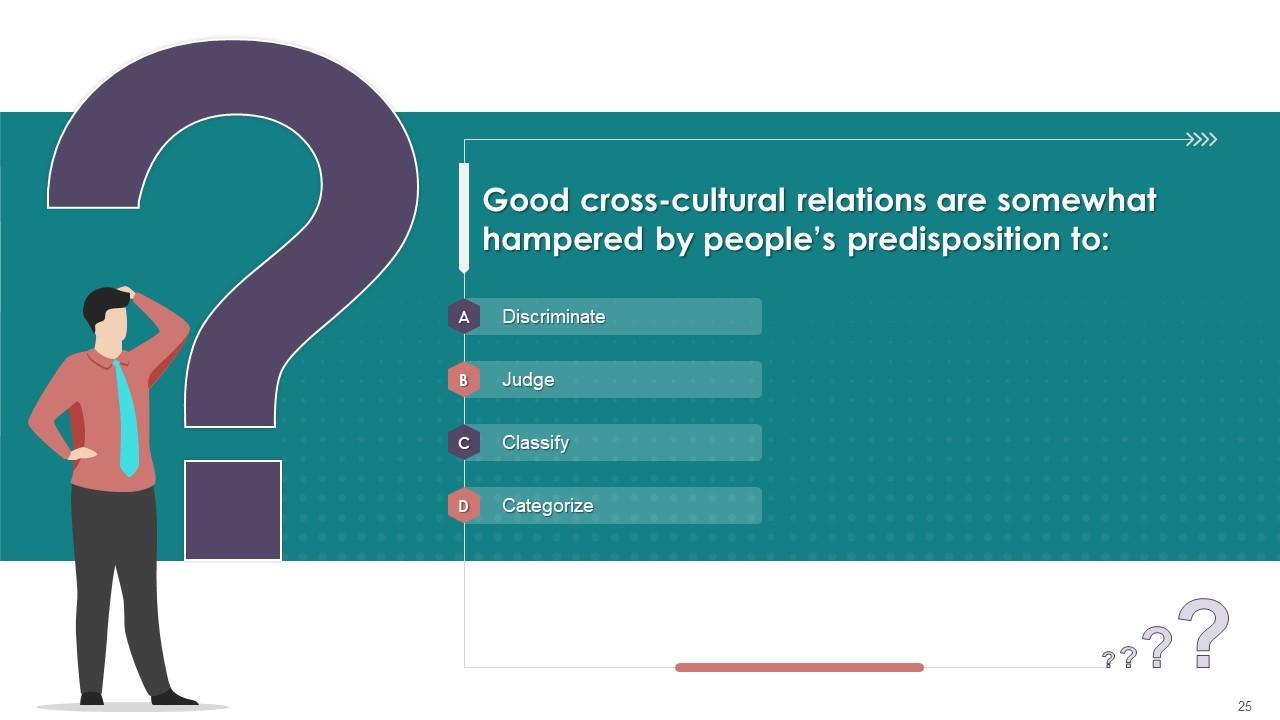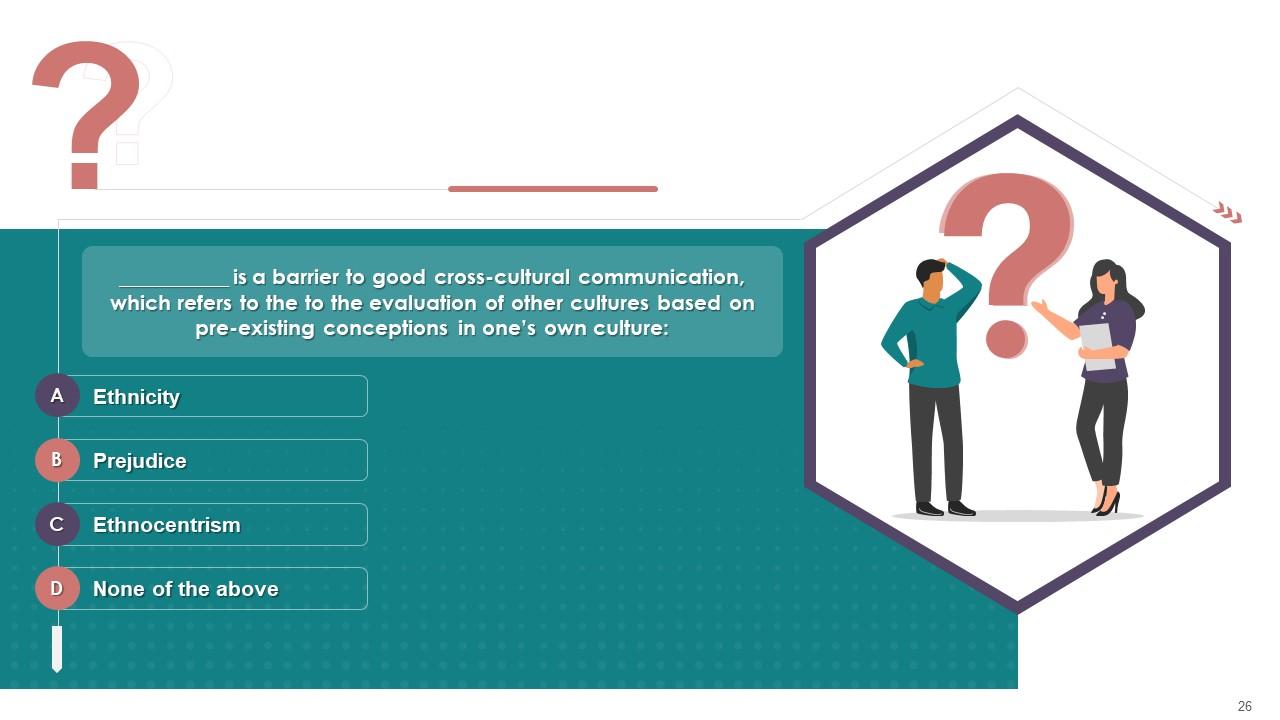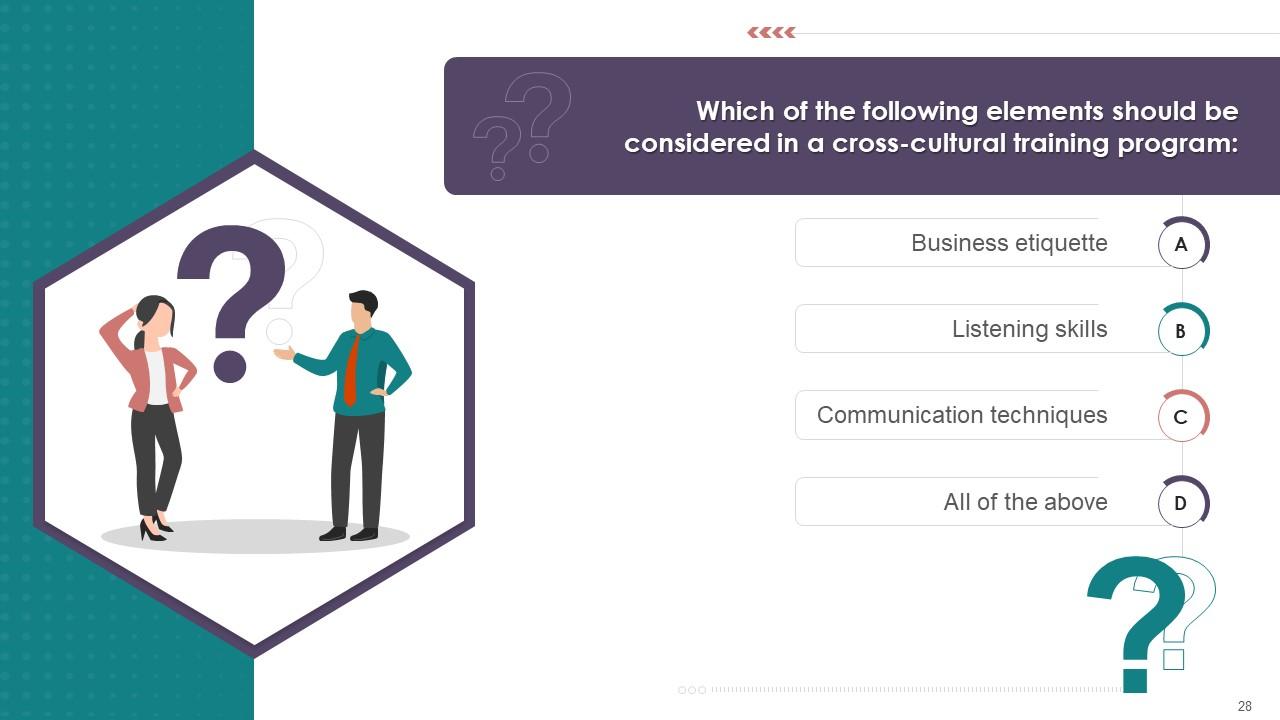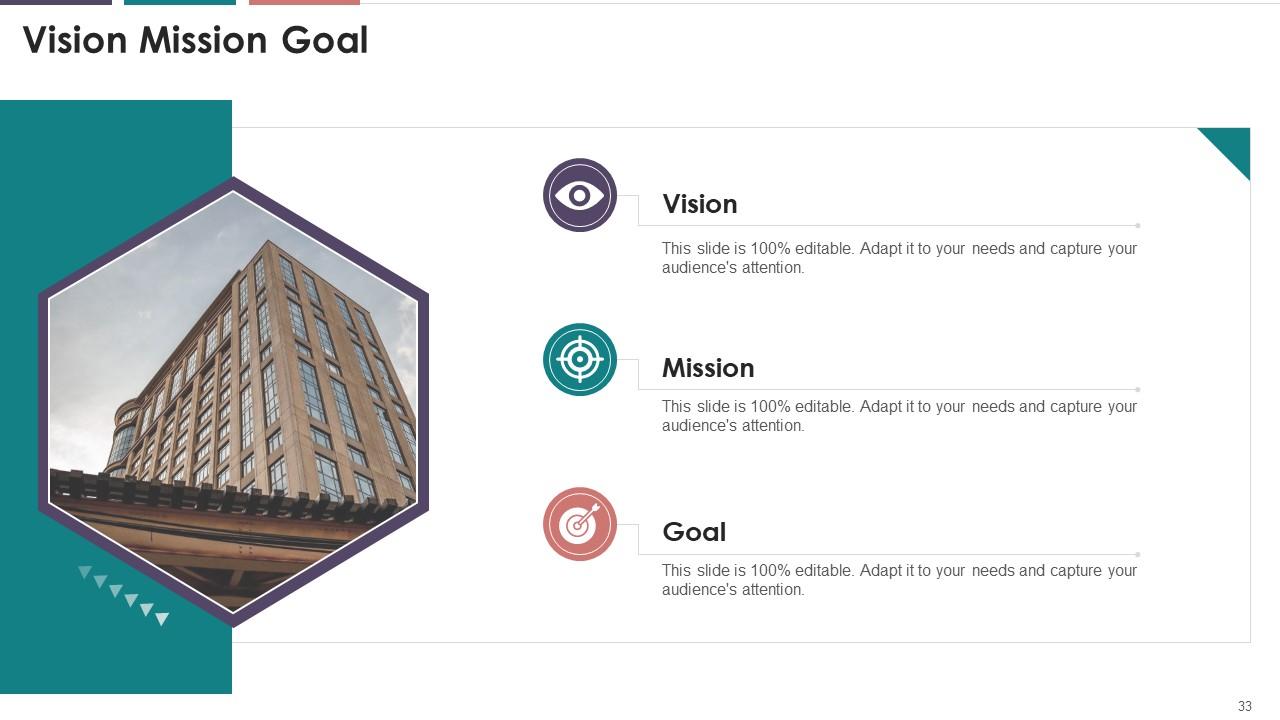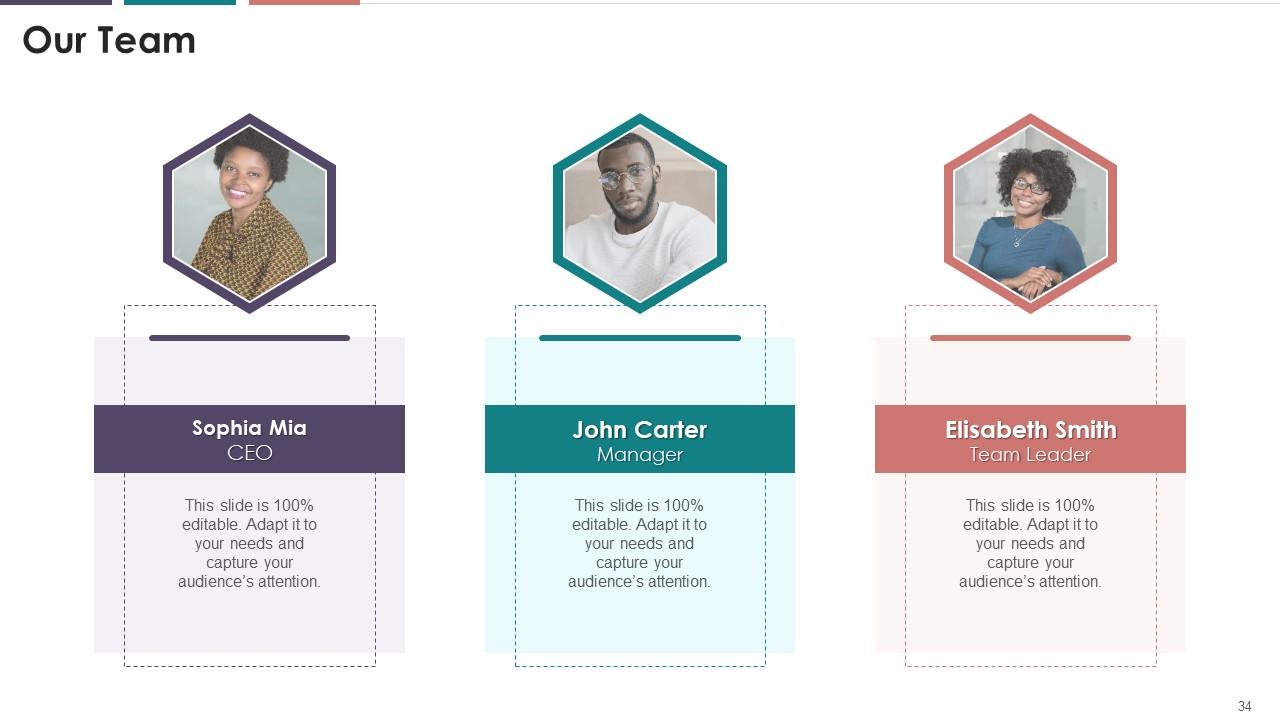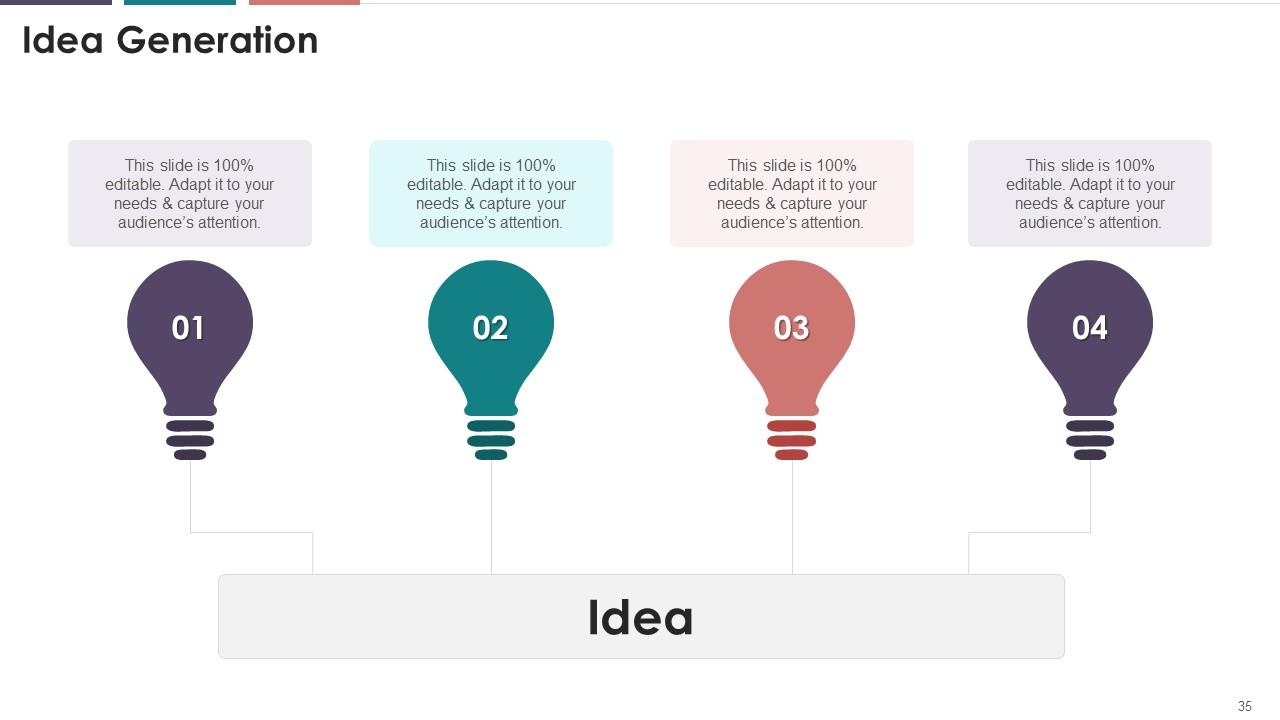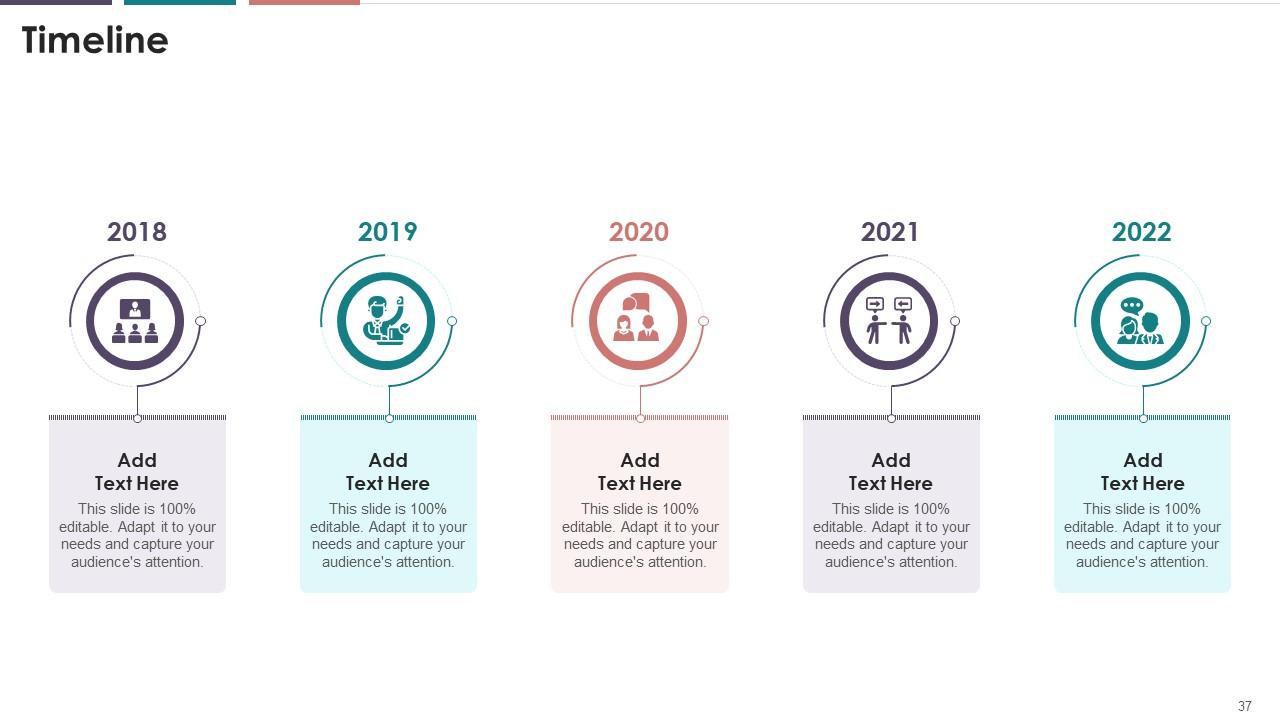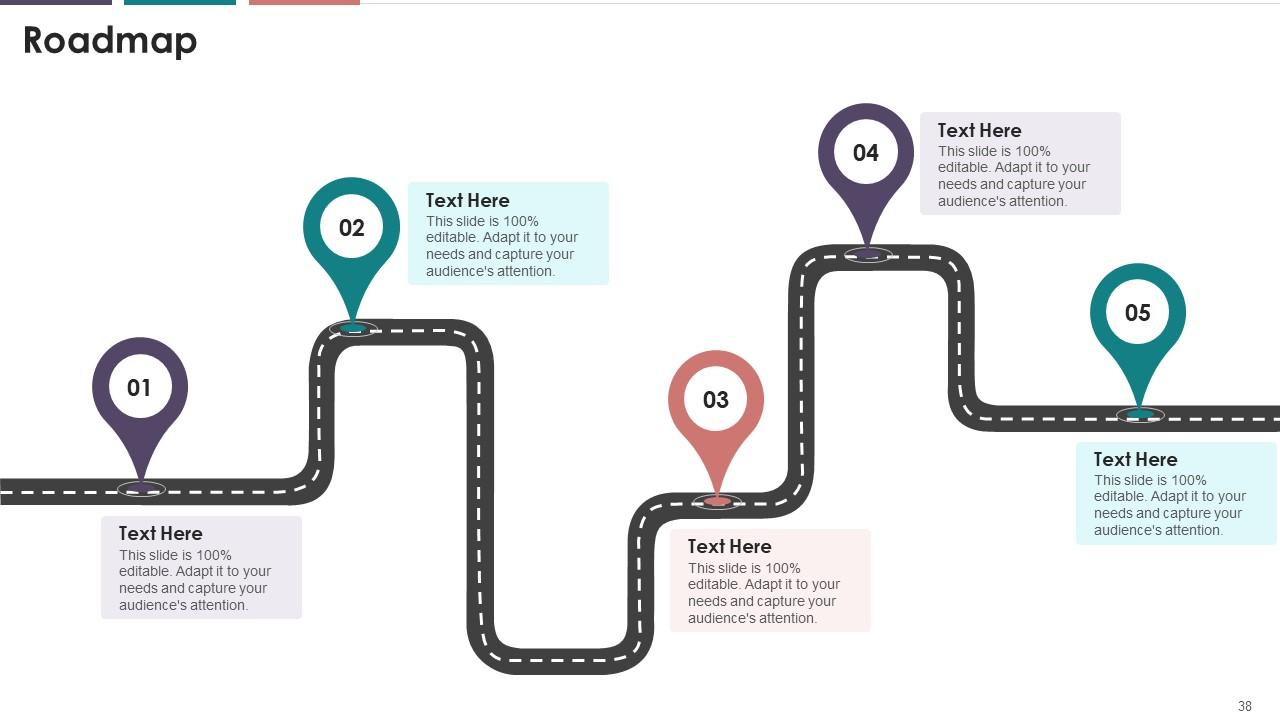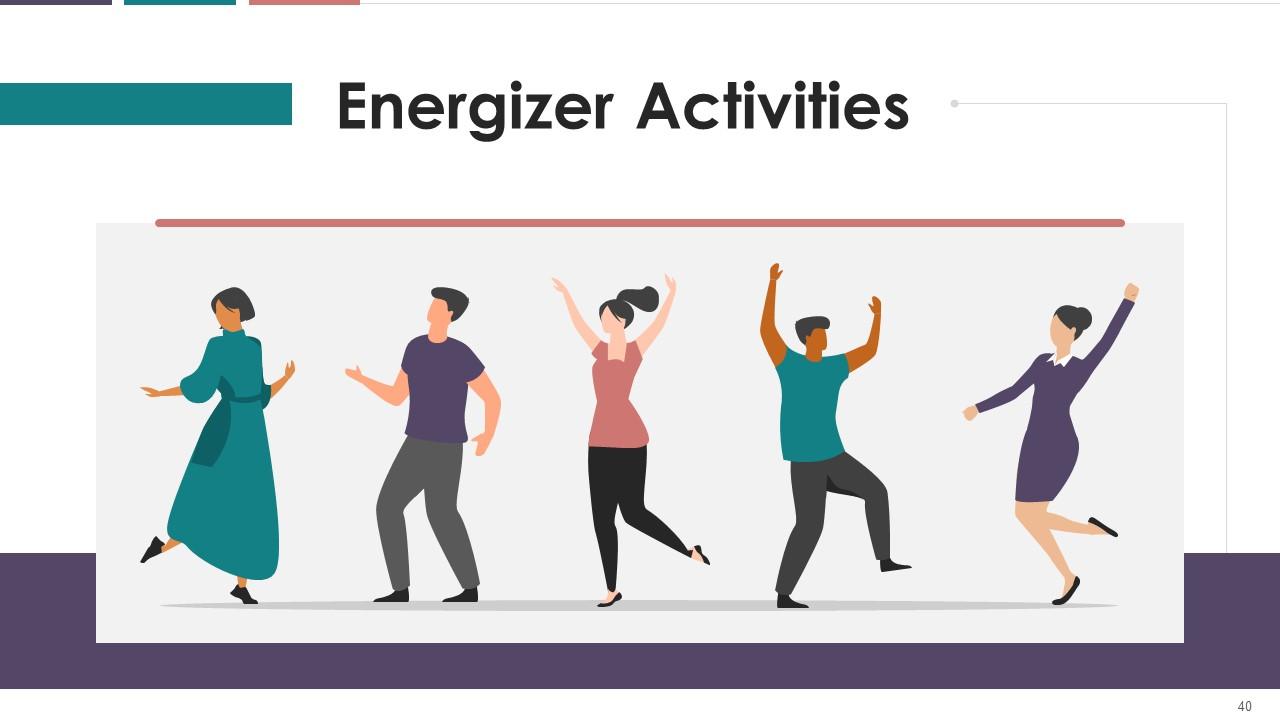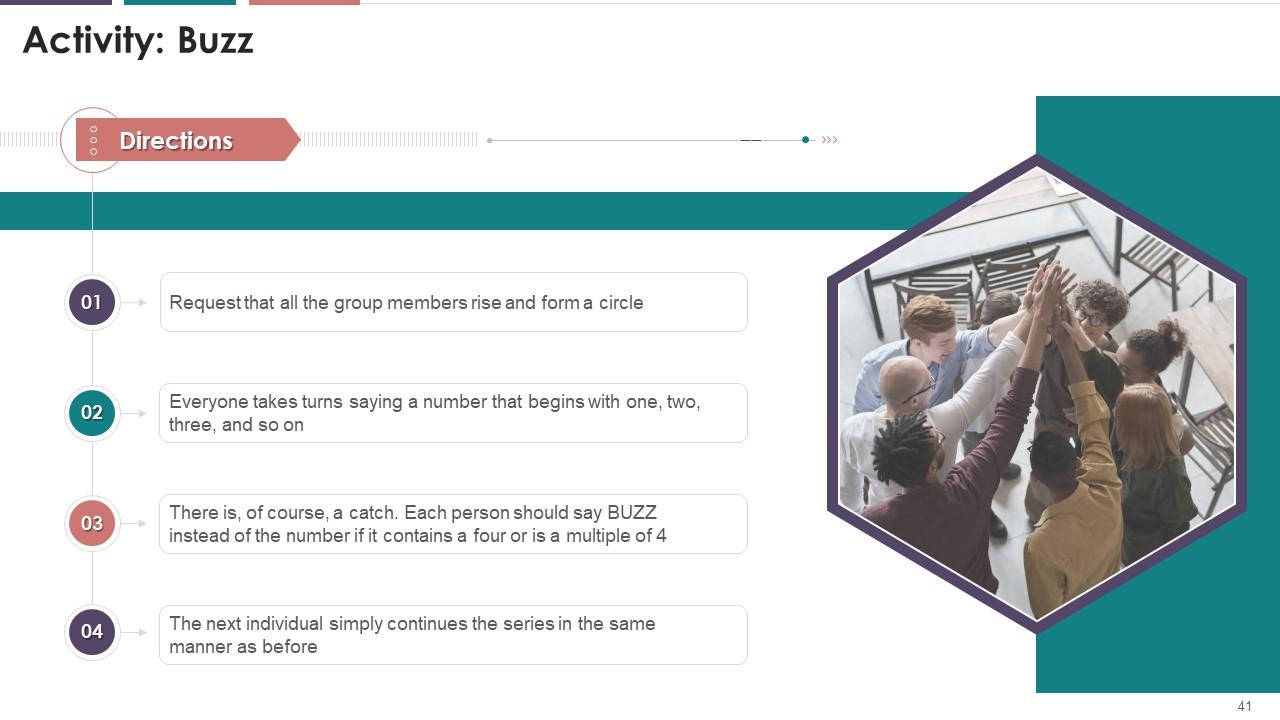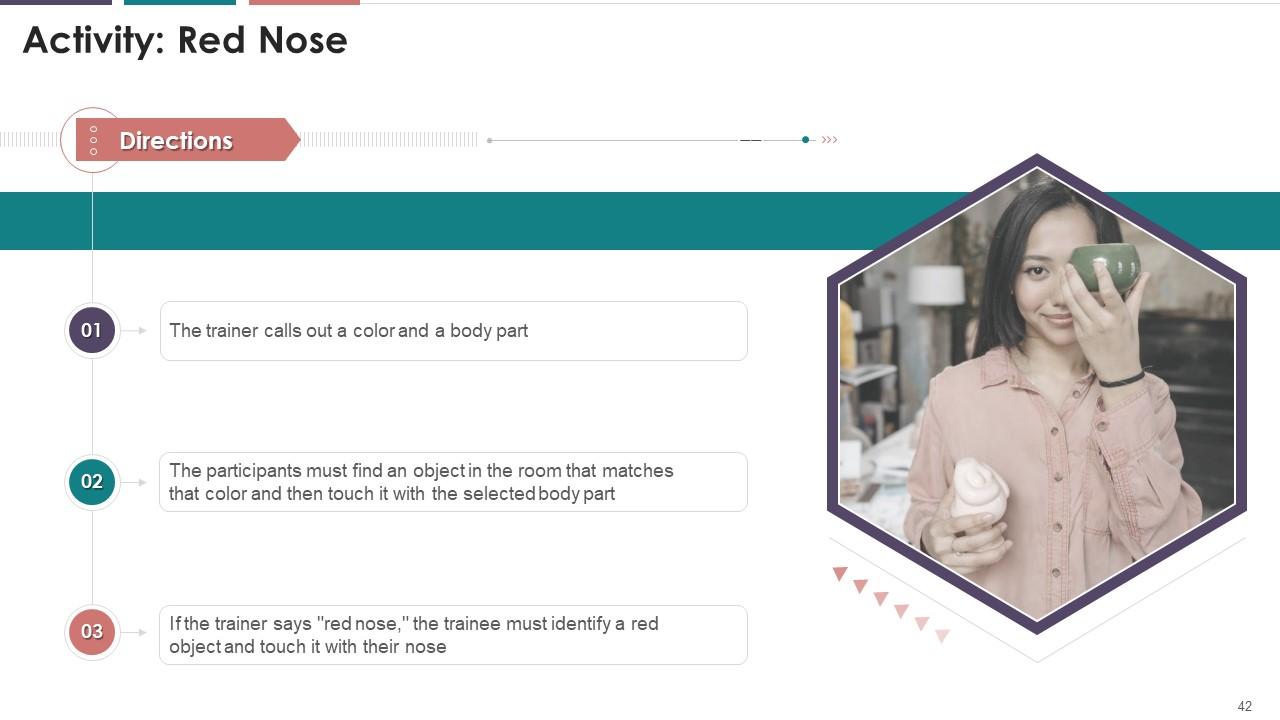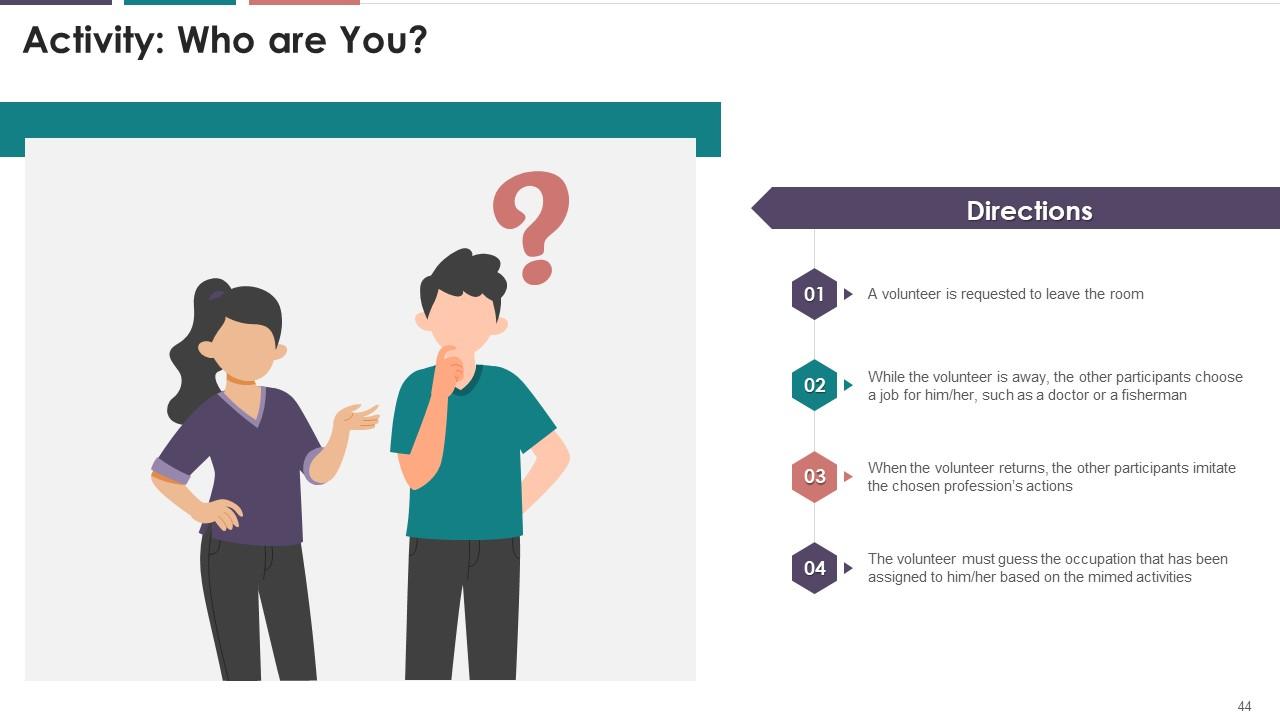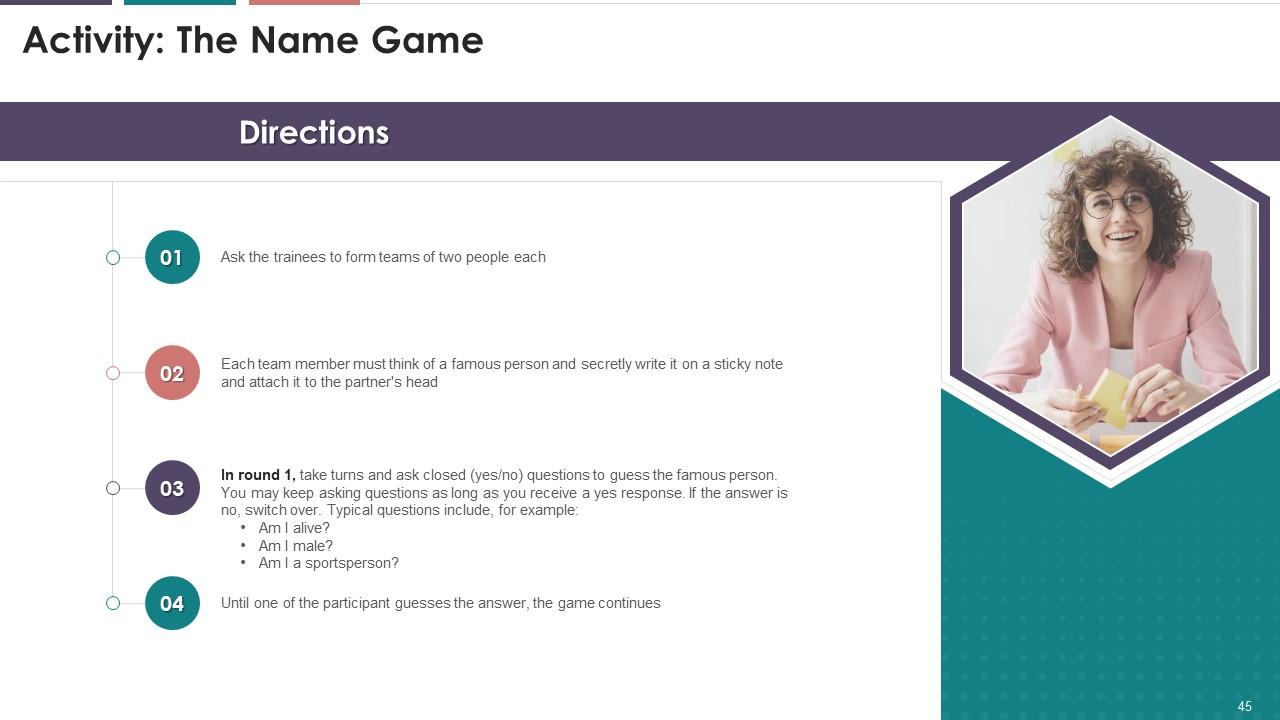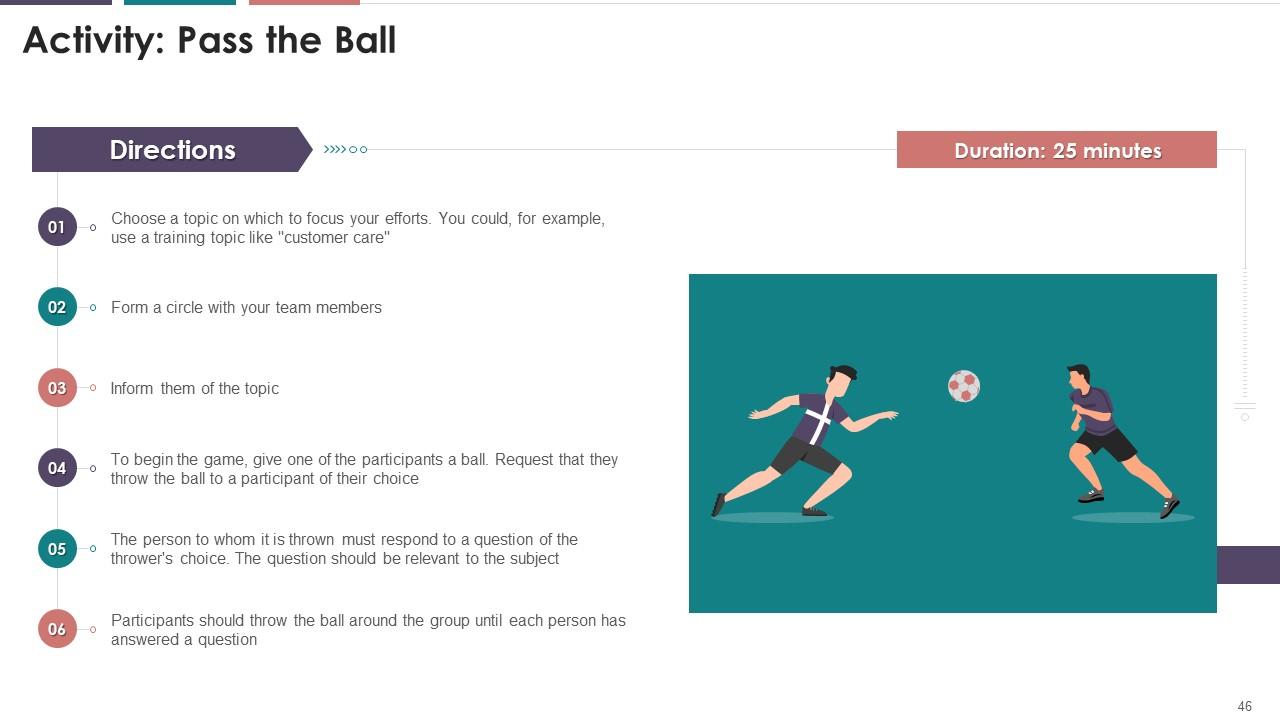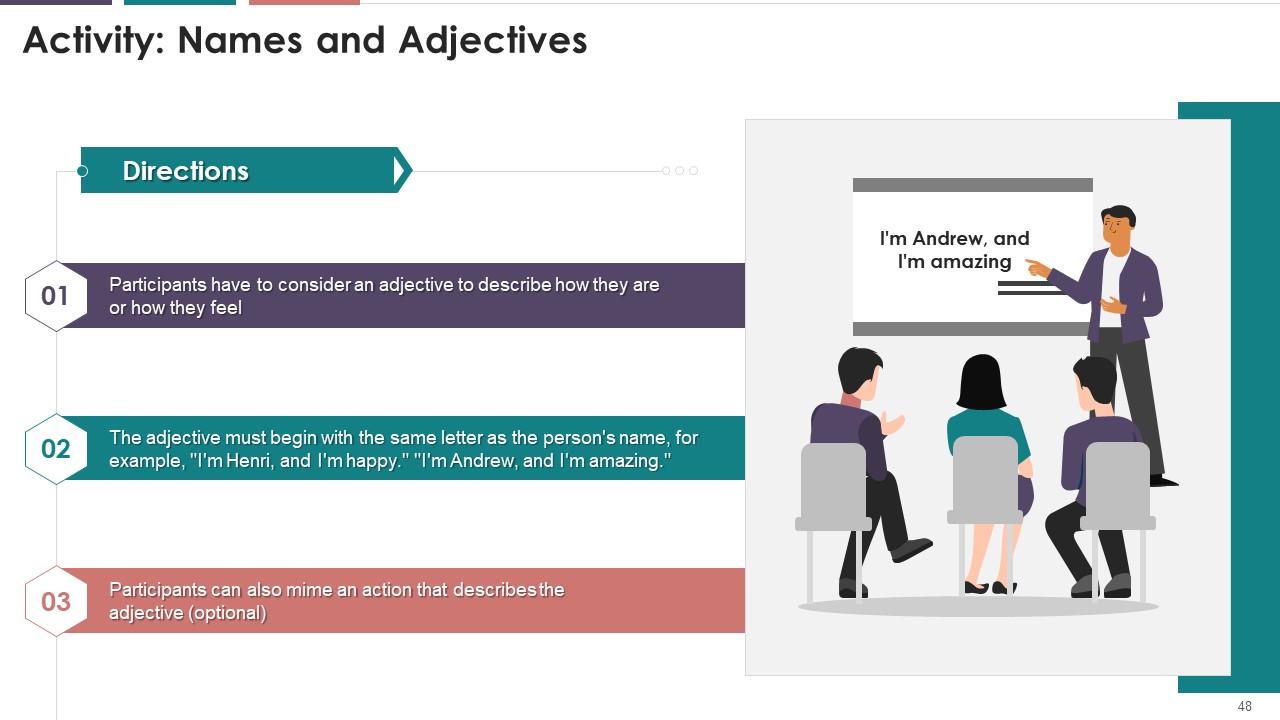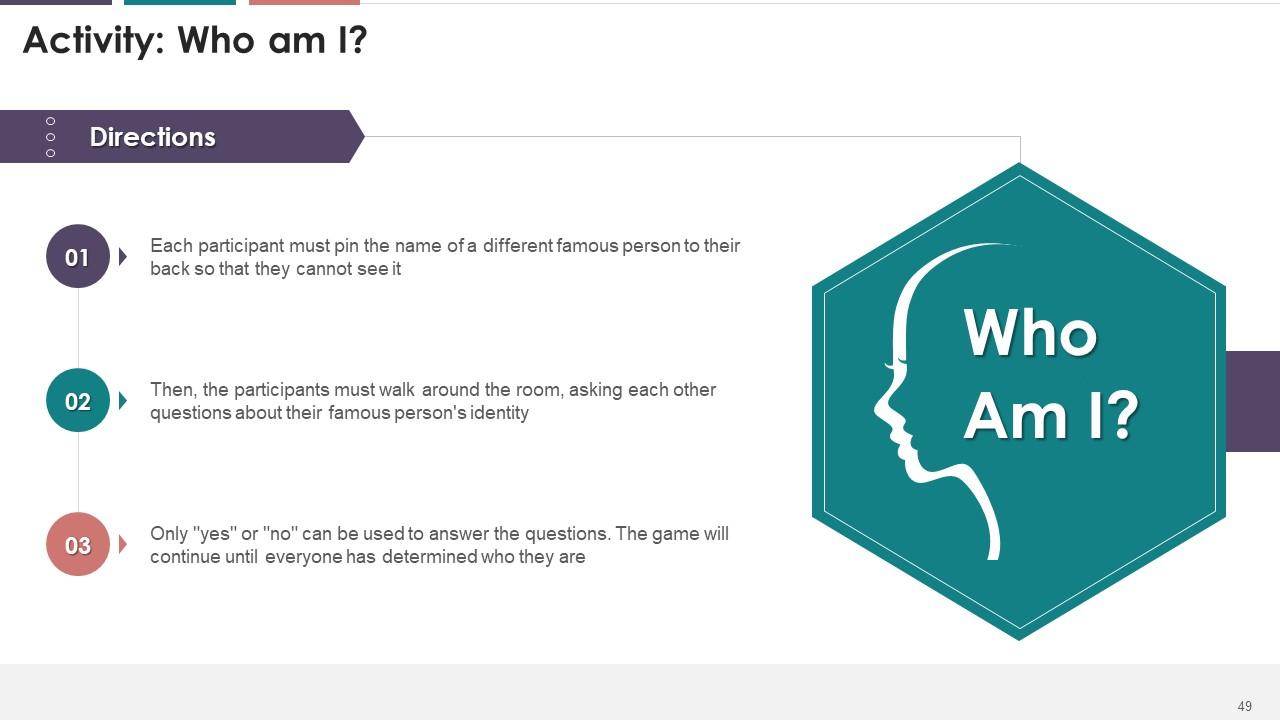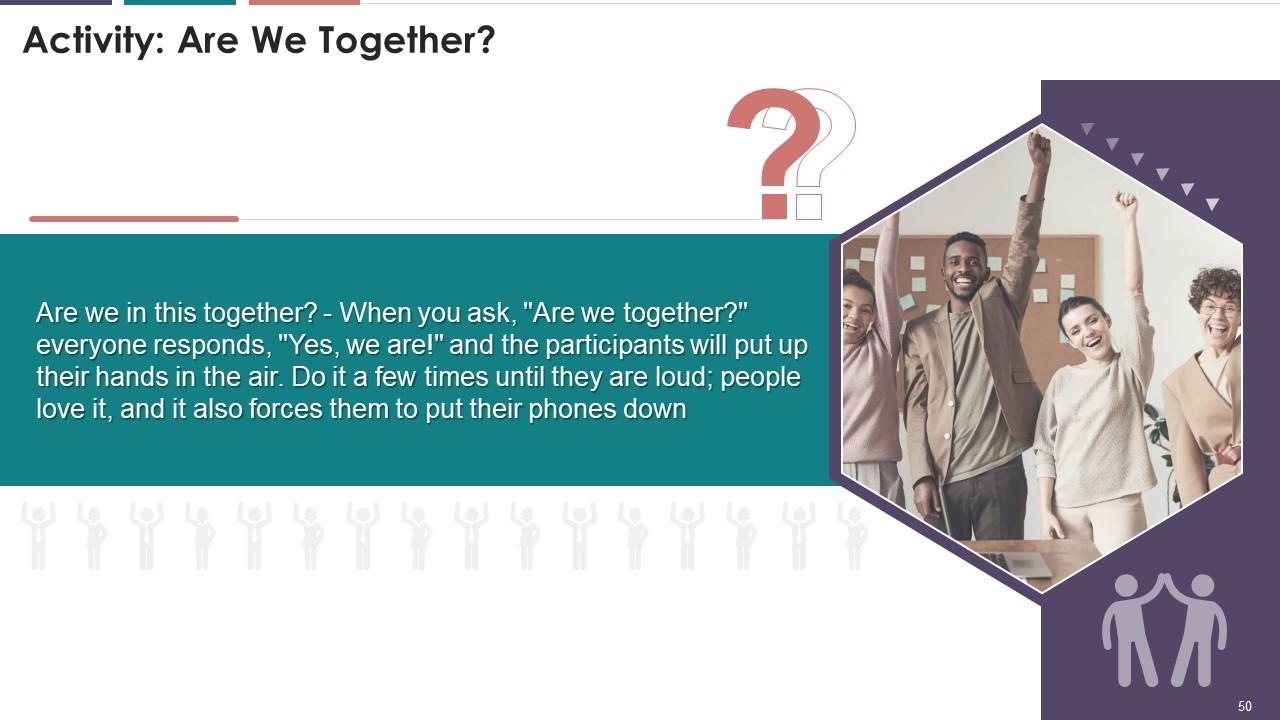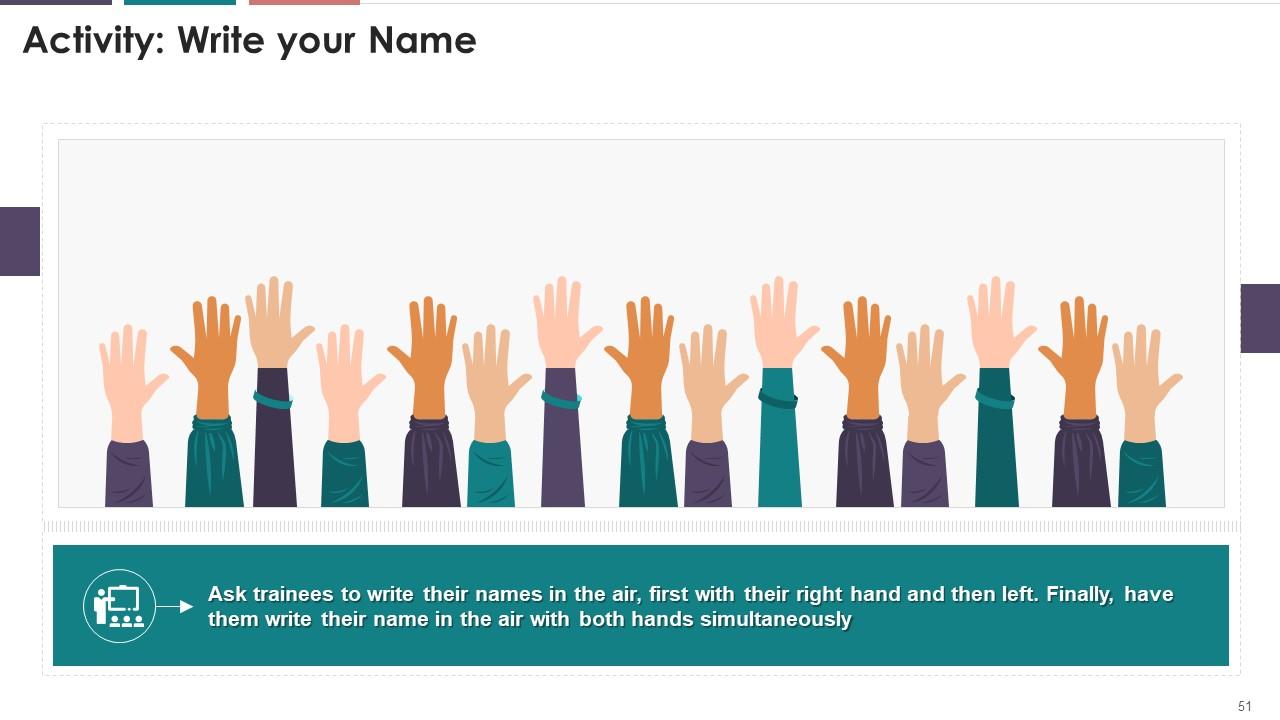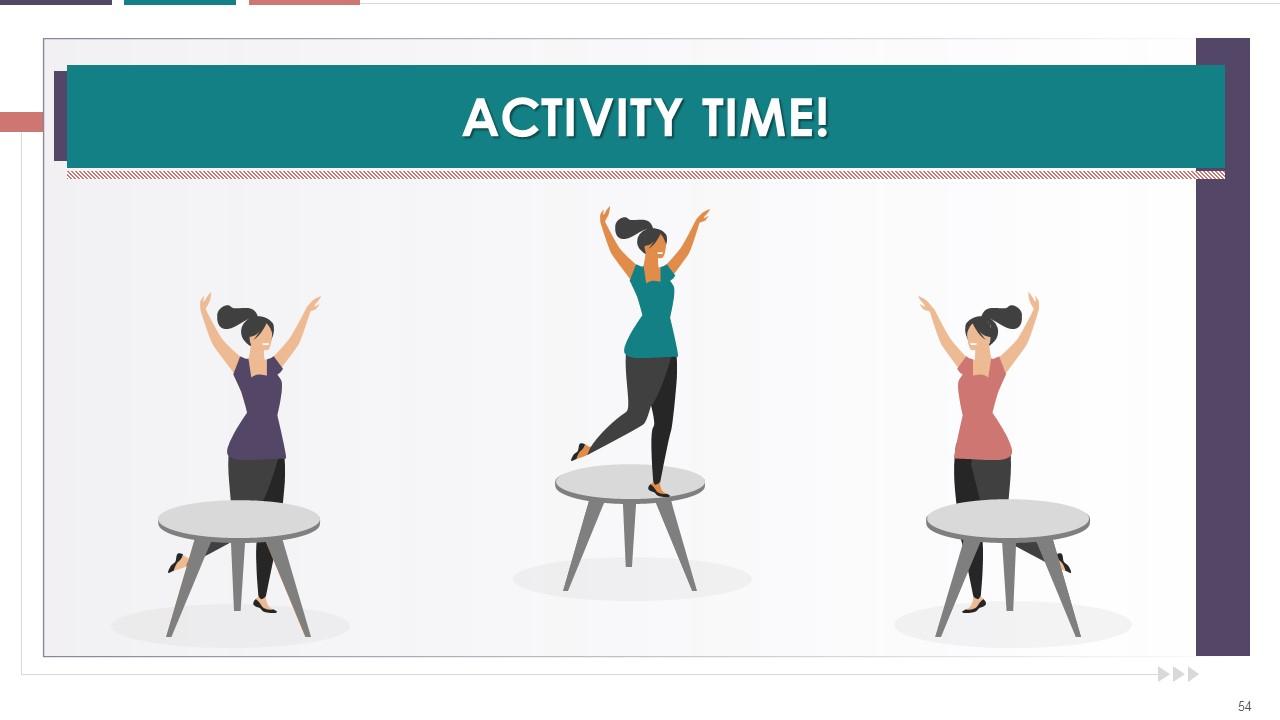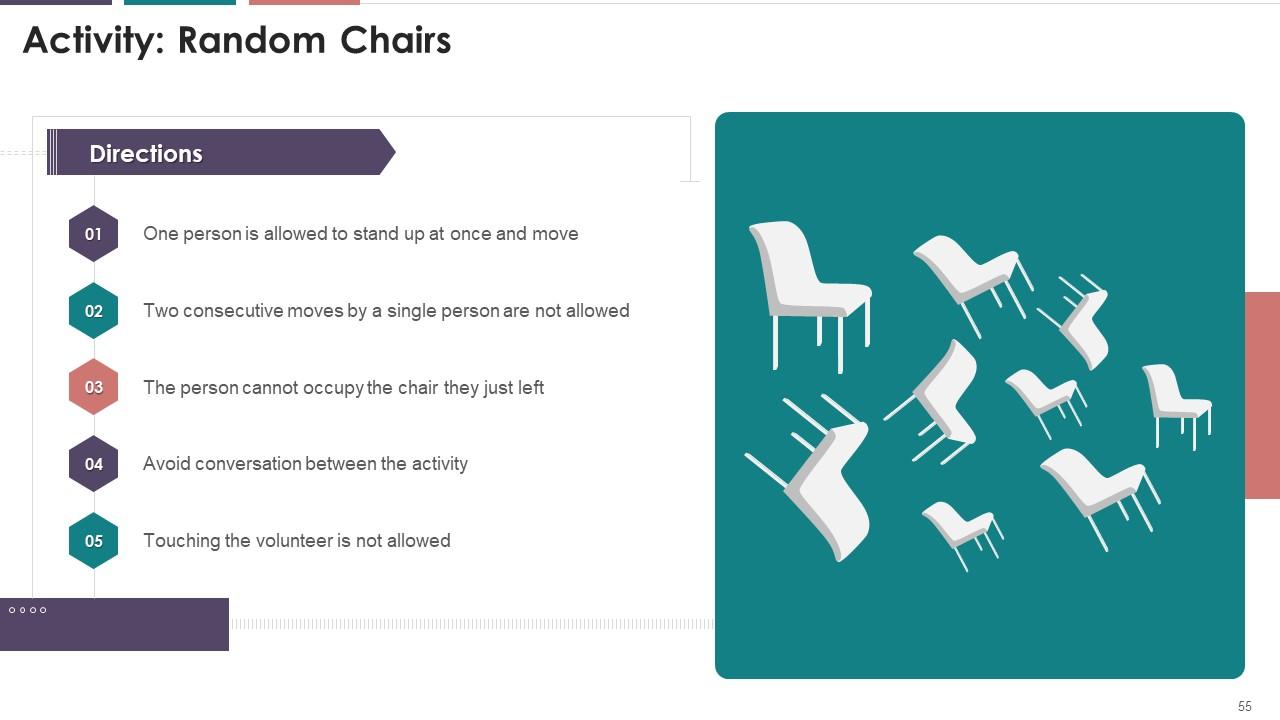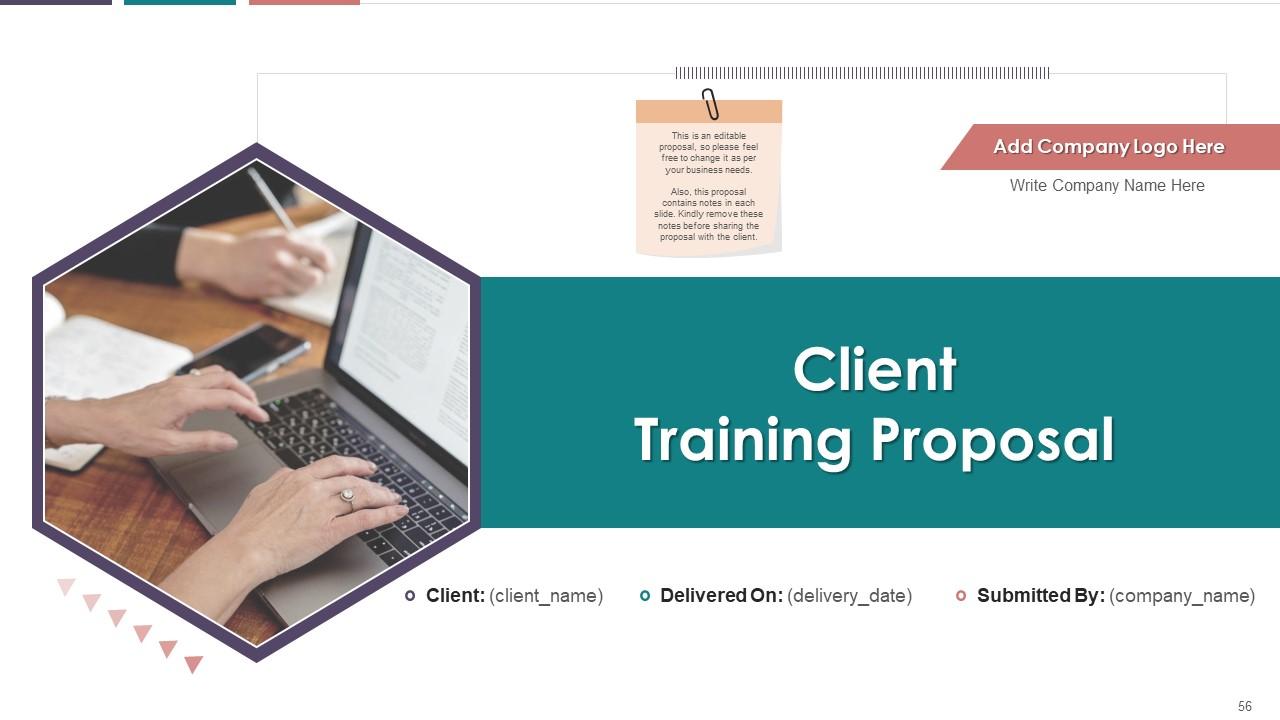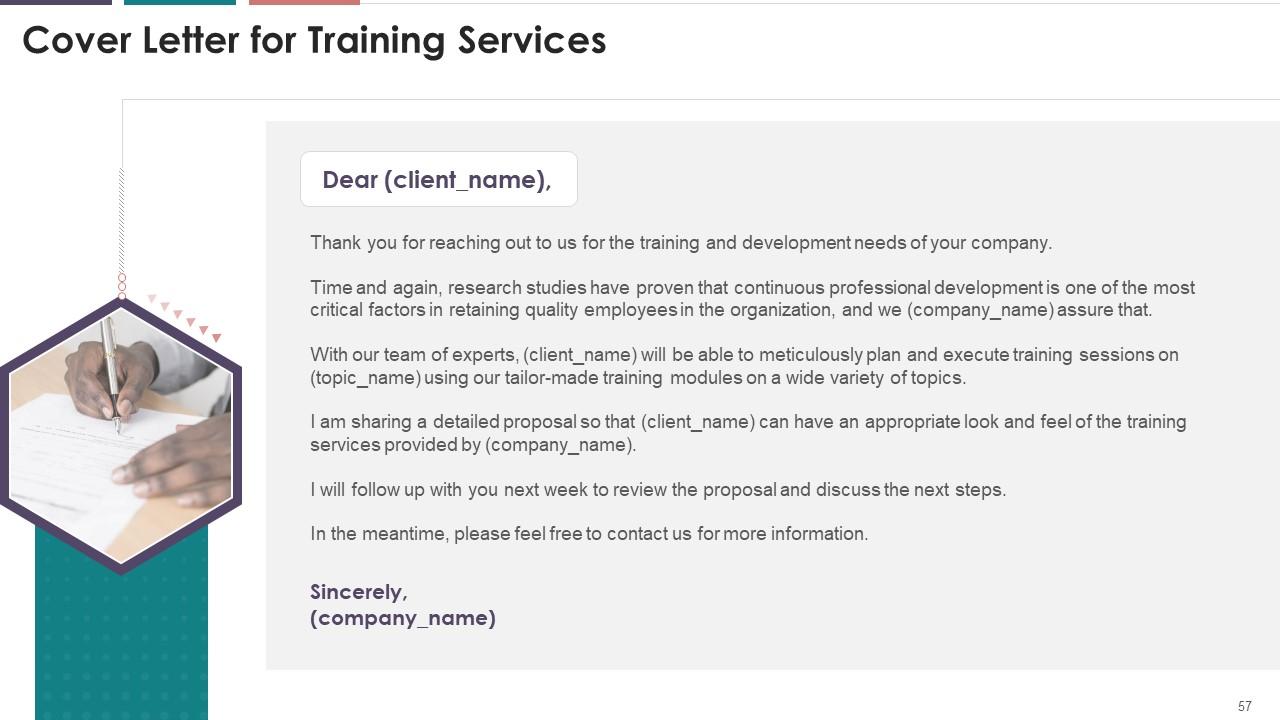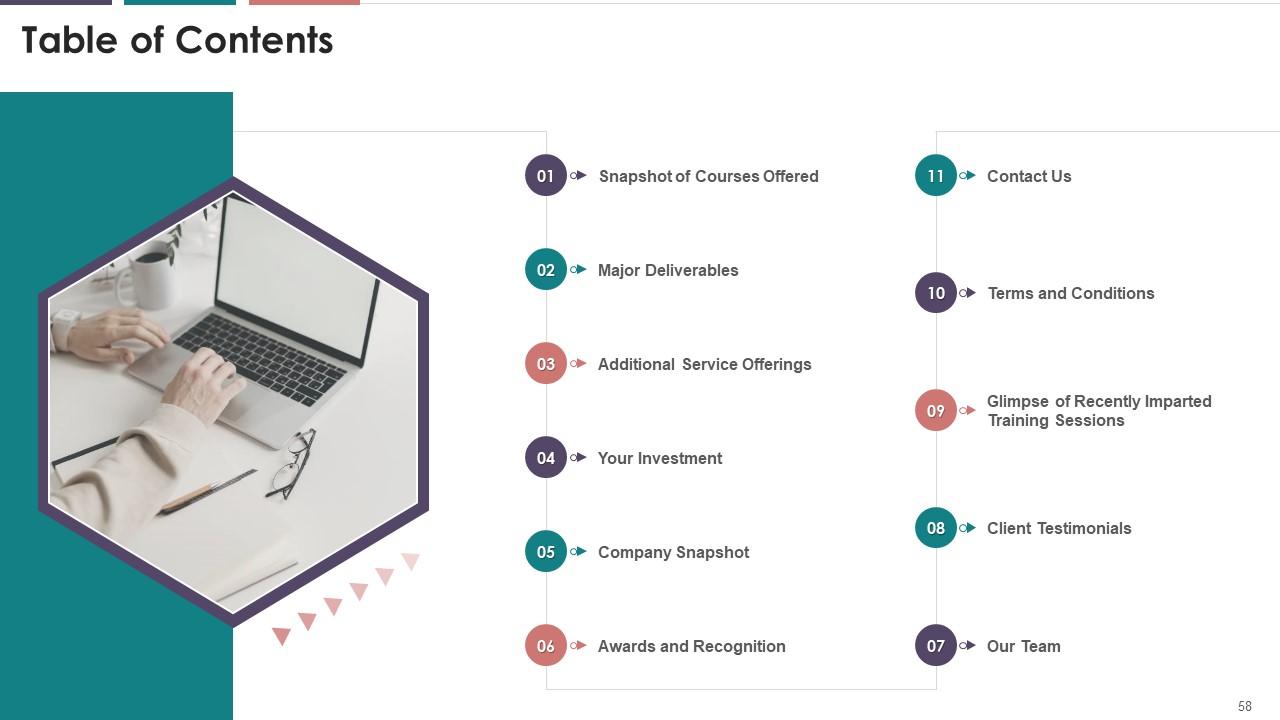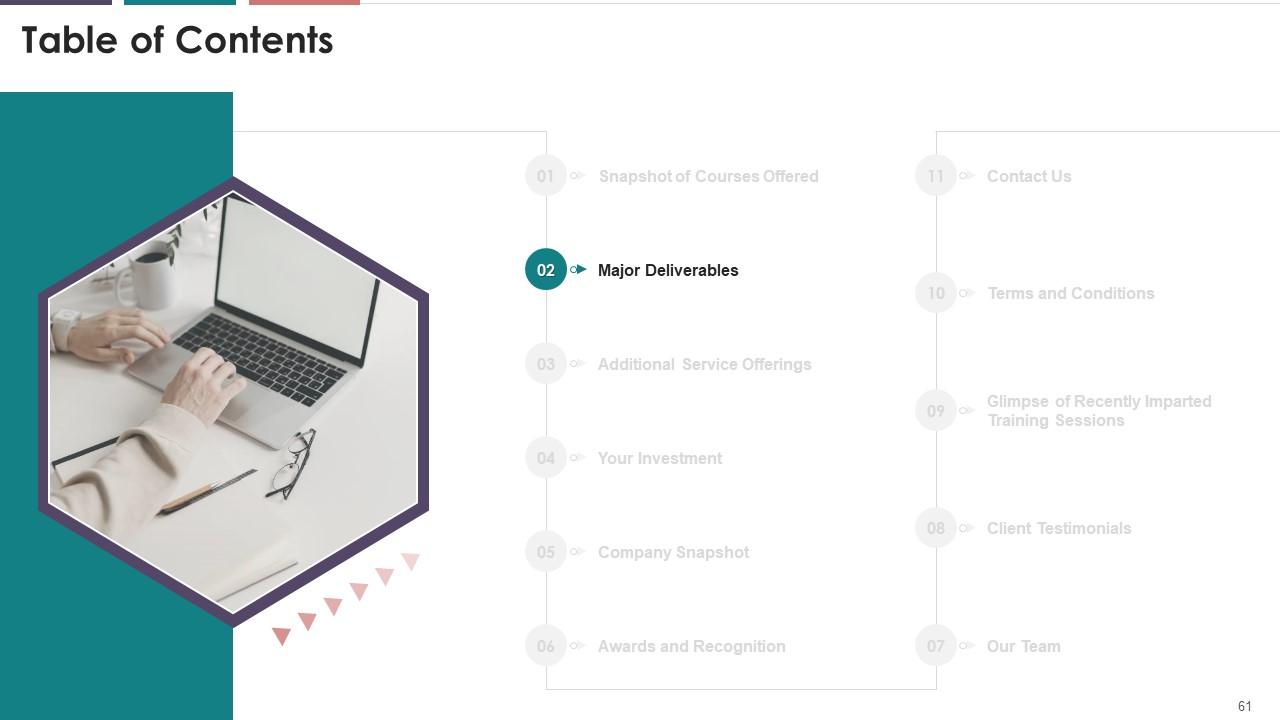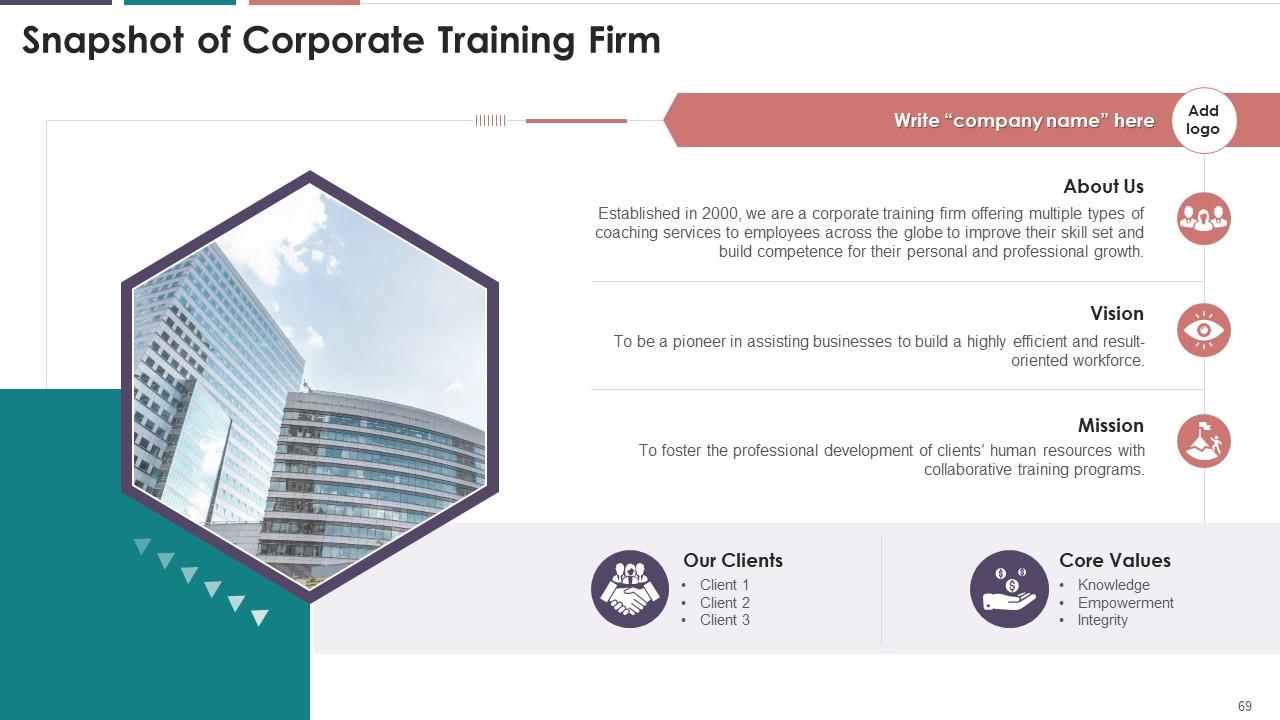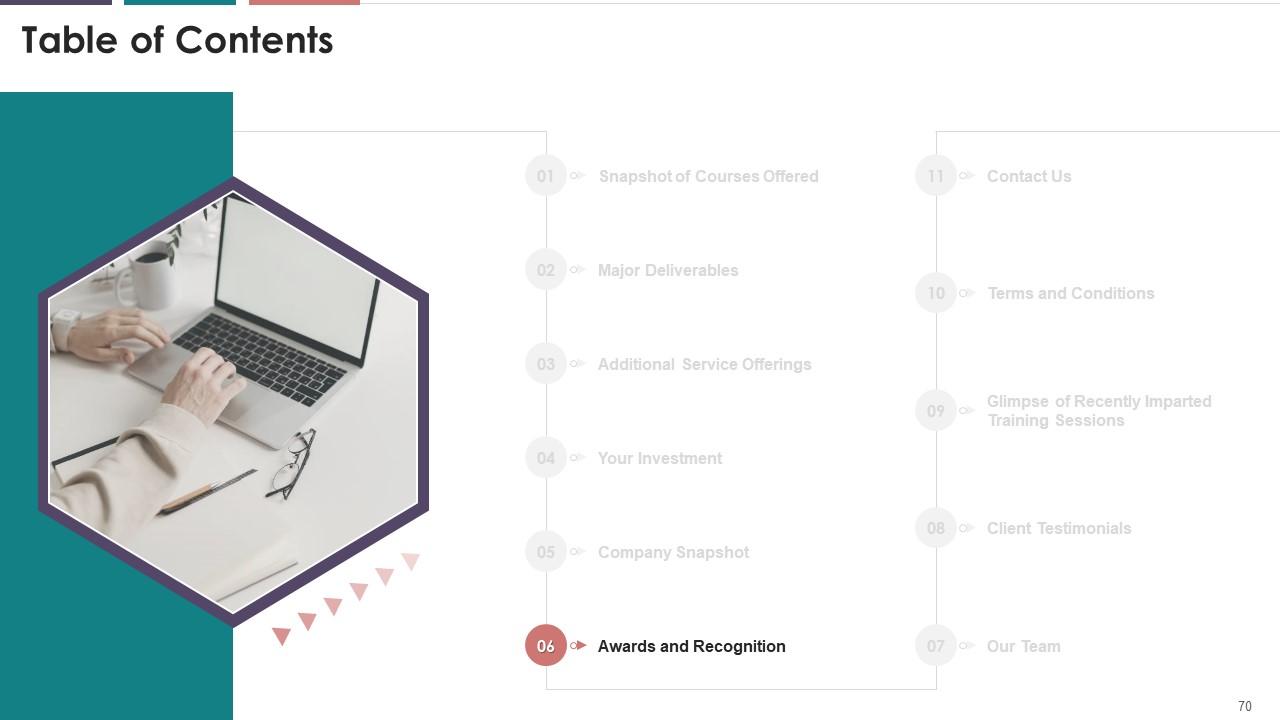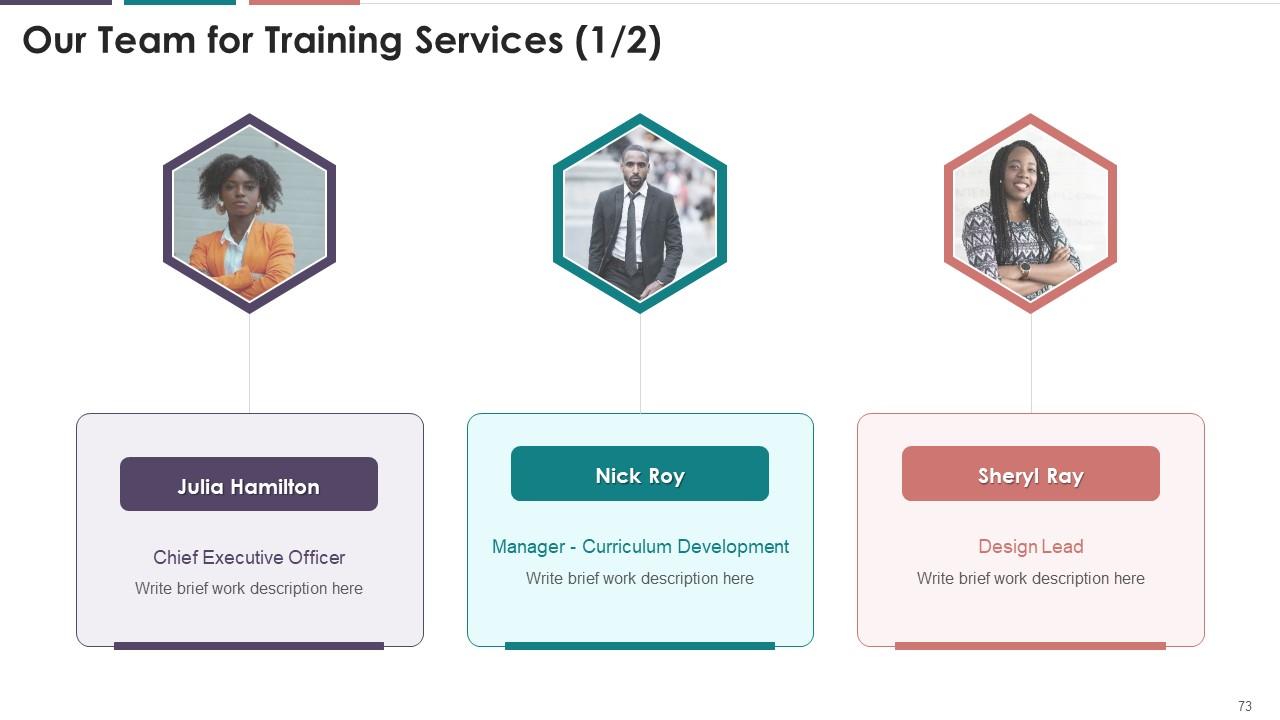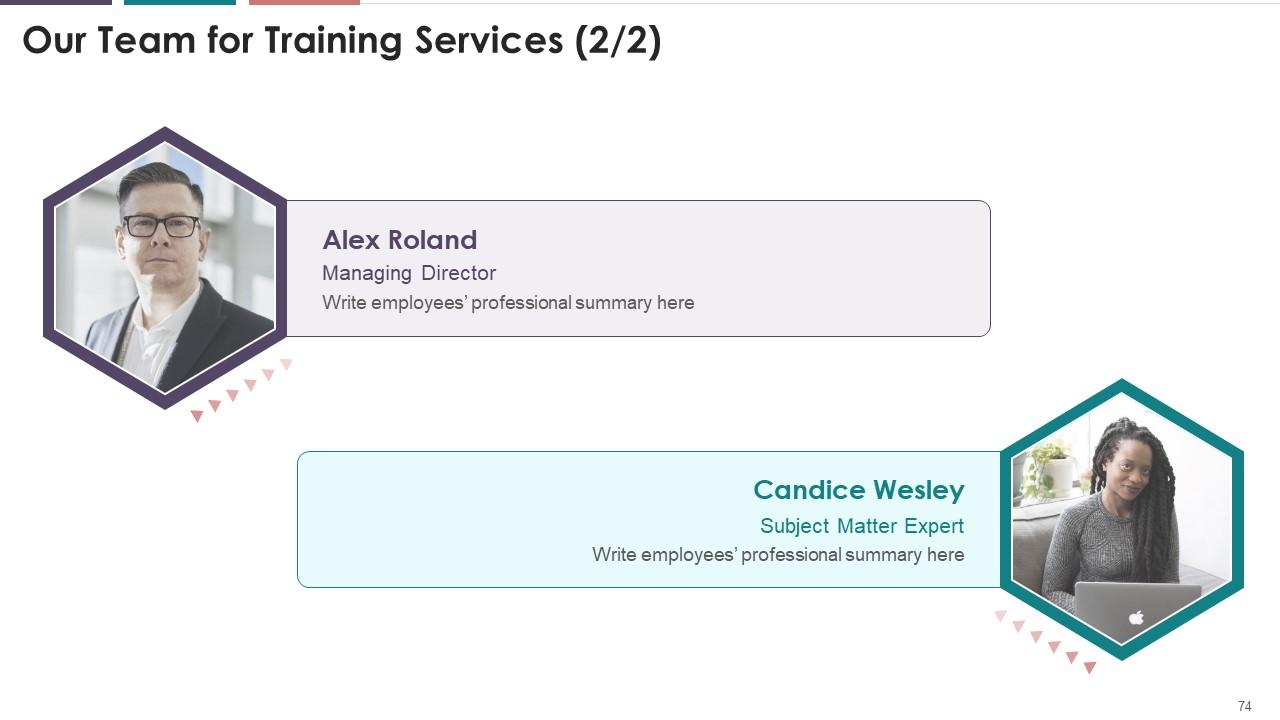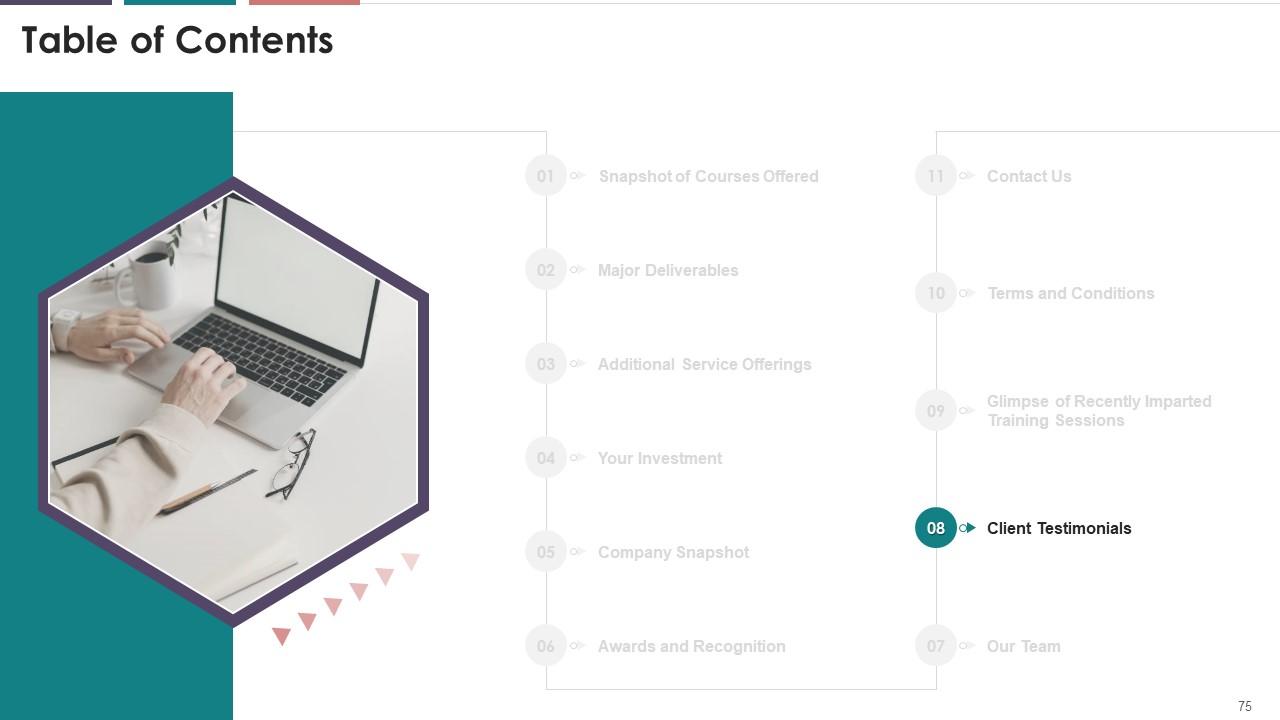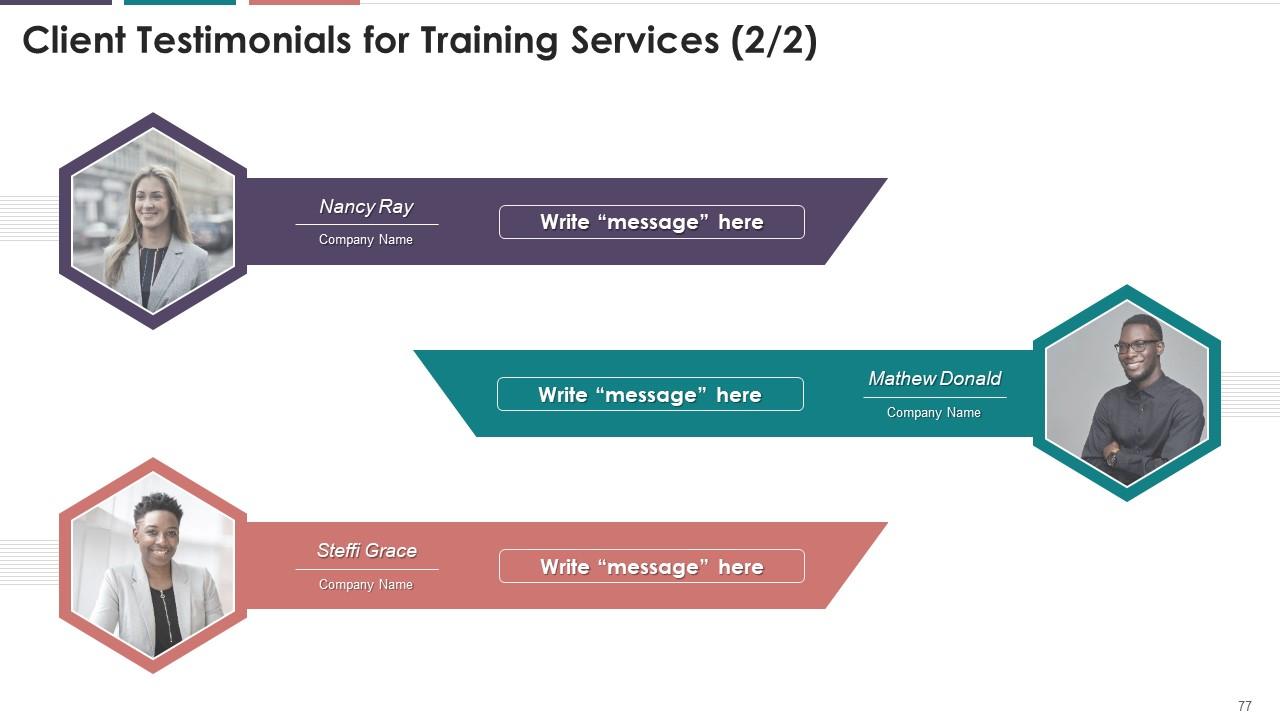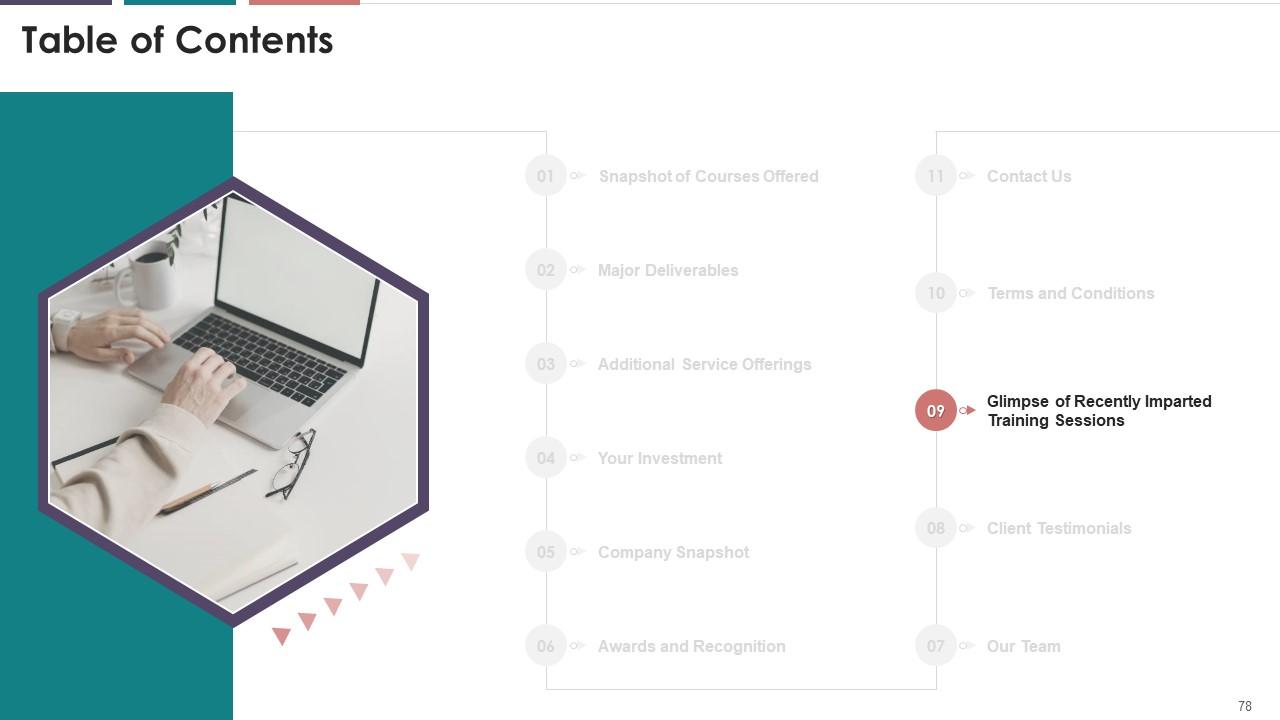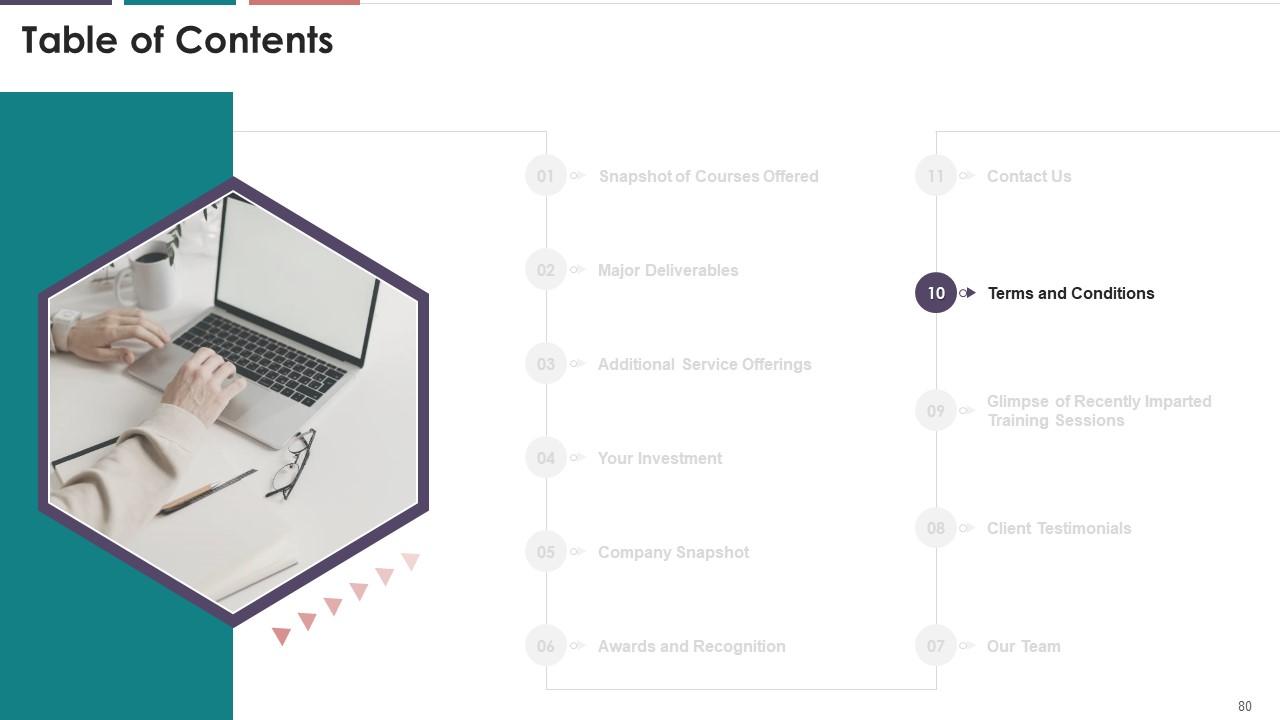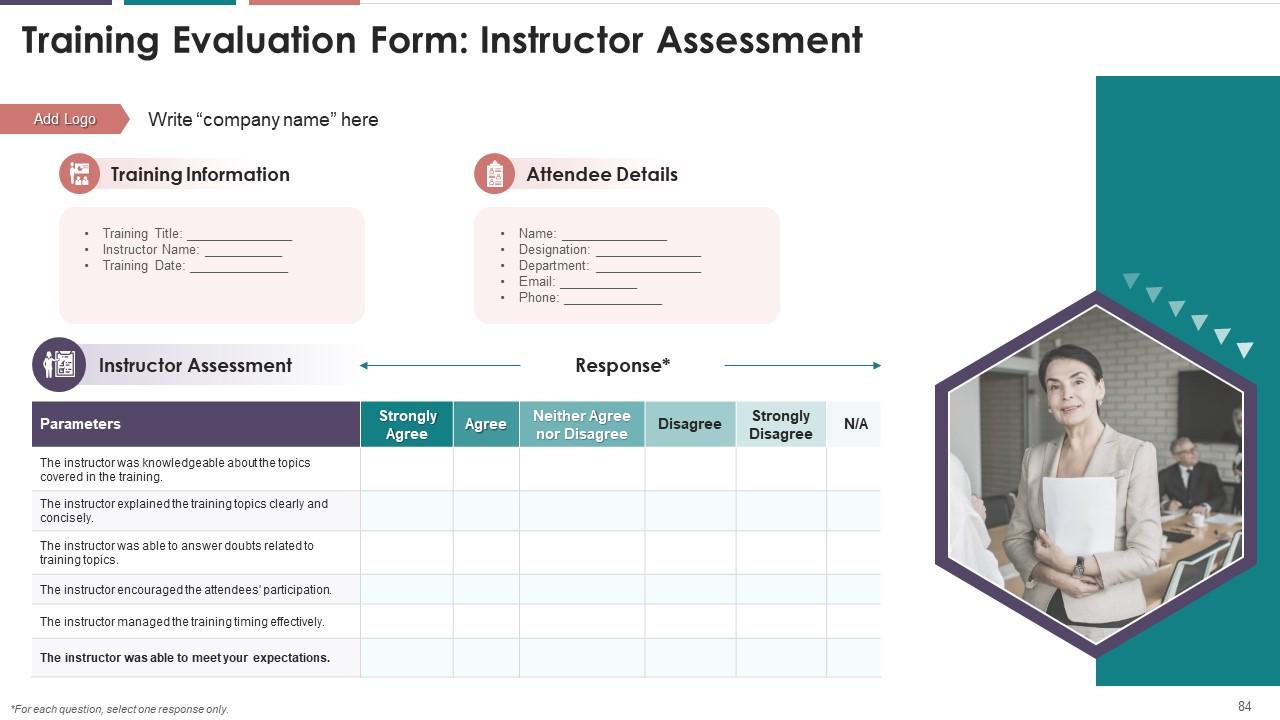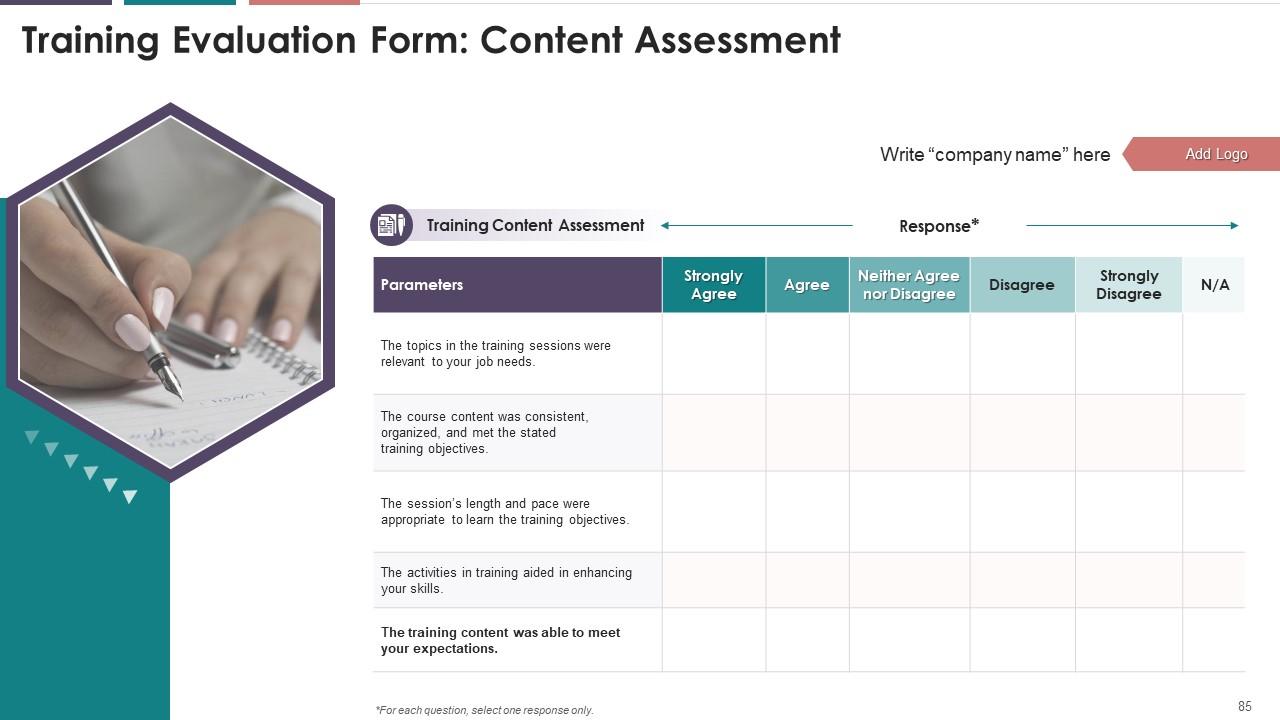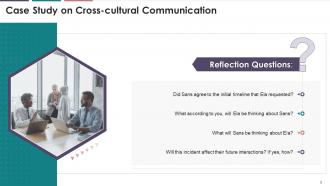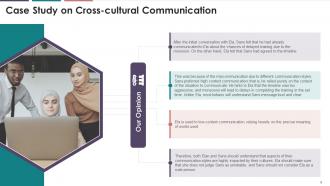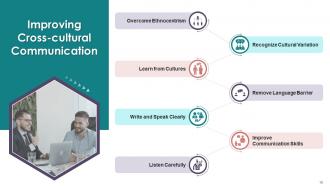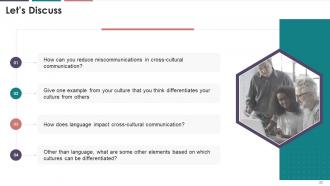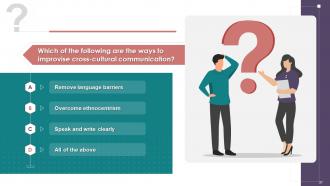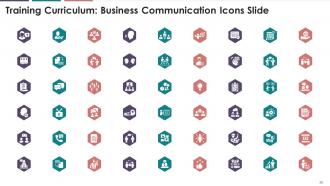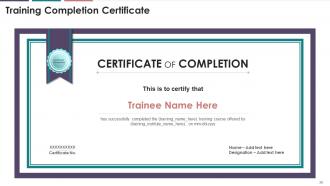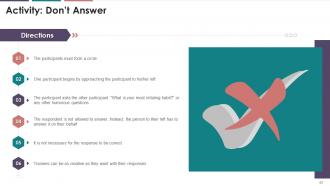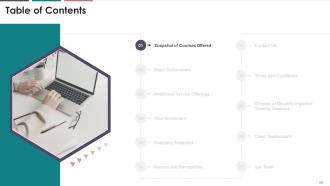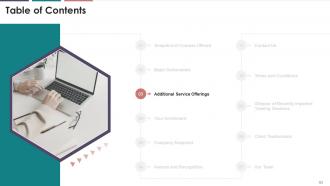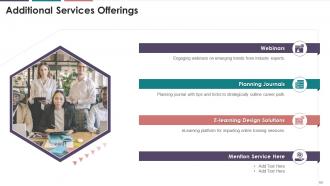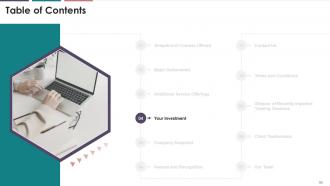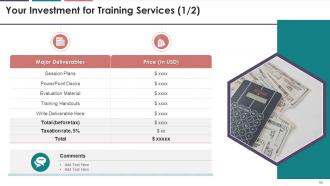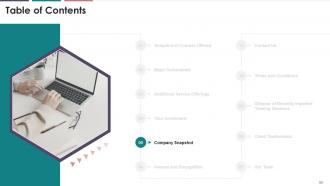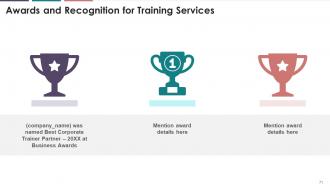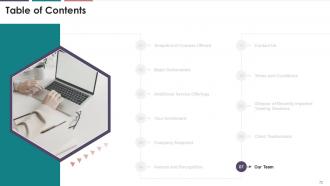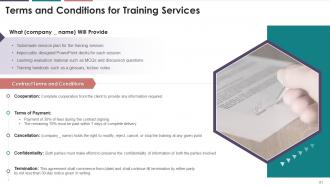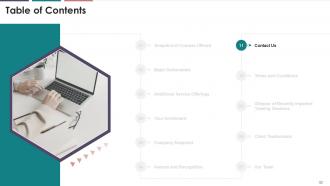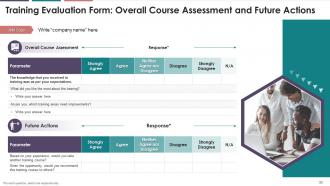Cross Cultural Communication Training Module On Business Communication Edu Ppt
This PowerPoint training deck explains the concept of Cross-cultural Communication. It contains slides on six patterns of cultural differences, the significance, and sources of miscommunication in Cross-cultural communication. Also, it covers the factors and tips to improve Cross-cultural communication. The PPT module also contains key takeaways, discussion questions, MCQs, case study, and memes to make the training session interactive. Further, it includes additional slides on about us, vision, mission, goal, 30-60-90 days plan, timeline, roadmap, training completion certificate, energizer activities, detailed client proposal, and training assessment form.
- Google Slides is a new FREE Presentation software from Google.
- All our content is 100% compatible with Google Slides.
- Just download our designs, and upload them to Google Slides and they will work automatically.
- Amaze your audience with SlideTeam and Google Slides.
-
Want Changes to This PPT Slide? Check out our Presentation Design Services
- WideScreen Aspect ratio is becoming a very popular format. When you download this product, the downloaded ZIP will contain this product in both standard and widescreen format.
-

- Some older products that we have may only be in standard format, but they can easily be converted to widescreen.
- To do this, please open the SlideTeam product in Powerpoint, and go to
- Design ( On the top bar) -> Page Setup -> and select "On-screen Show (16:9)” in the drop down for "Slides Sized for".
- The slide or theme will change to widescreen, and all graphics will adjust automatically. You can similarly convert our content to any other desired screen aspect ratio.
Compatible With Google Slides

Get This In WideScreen
You must be logged in to download this presentation.
PowerPoint presentation slides
Presenting Training Module on Cross-cultural Communication. This presentation deck contains 86 well-researched and uniquely designed slides. These slides are 100 percent made in PowerPoint and are compatible with all screen types and monitors. They also support Google Slides. Premium Customer Support available. Suitable for use by managers, employees, and organizations. These slides are easily customizable. You can edit the color, text, icon, and font size to suit your requirements.
People who downloaded this PowerPoint presentation also viewed the following :
Content of this Powerpoint Presentation
Slide 4
This slide explains the meaning of culture.
Slide 5
This slide mentions the most common reasons
for cultural differences, such as different communication styles, attitudes
towards conflict, approaches to completing tasks, decision-making styles,
attitudes towards disclosure, and different approaches to knowing.
Instructor’s Notes:
·
Different communication styles: Communication
styles vary widely between cultures. There are various aspects in which
communication differs, out of which, one of the vital aspects is language
usage. Across different cultures, different words and phrases are used in
various ways. Taking an example, the meaning of the word "Yes" varies
from 'definitely' to 'may be' or 'i'll consider' in different cultures. Another
factor that should be given importance in communication style is non-verbal
communication. It includes not only facial expressions or gestures, but many
other factors like distance, space, etc.. Many other aspects of communication
differ from culture to culture, so understanding the cultural differences and
accepting them is the best way to avoid miscommunication
·
Different attitude towards conflict: Different
people have different attitudes toward the situation of a conflict. Some
cultures view it as positive, while others view it as something to be avoided.
For Example, in the U.S., conflict is not usually desirable; but people are
encouraged to deal directly with disputes that arise. In fact, they prefer
face-to-face meetings to work out the existing issues. Whereas in the Eastern
countries, conflict is experienced as embarrassing or demeaning, and the
differences are best worked out quietly. They think that a written exchange is
a favored means to address the conflict
·
Different approaches in completing
tasks: People from different cultures choose different ways of
completing their tasks. Such differences might be due to varying perspectives
about work or relationship building, different mindsets, patterns, and varied
ideas about tasks allocated. For example, the Asian and Hispanic cultures
attach more value to establishing relationships within a team at the very
beginning of the project and then focusing entirely on the completion of the
task till the end. On the other hand,
European-Americans prioritize work initially and let relationships develop
during the tenure of the task. This does not reflect non-seriousness towards
the job from people belonging to any one of these cultural backgrounds or
valuing relationships more or less; it simply means that they may have
different ways and priorities
·
Different decision-making styles: The
decision-making criteria vary widely across different cultures. For example,
North Americans delegate the decisions frequently, meaning an official passes
the responsibility for some matter to a subordinate. Whereas the Southern
European and Latin American countries place a strong value on taking decision
oneself. The organization should always know that the individual's expectations
about their role shapes the decision, which its culture might highly influence
·
Different attitude towards disclosure:
While
dealing with a conflict, an individual should be mindful that people differ in
the comfort regarding disclosure. Not every person who is a part of a conflict
feels comfortable revealing or discussing it. Questions that one person feels
comfortable asking might be intrusive to others. So, attitude towards
disclosure is also something to be considered along with other factors
Slide 7 to 9
These slides illustrate a case study on cross-cultural
communication.
Slide 11
This slide covers the meaning of cross-cultural
communication.
Slide 12
This slide illustrates various points showing the
importance of cross-cultural communication.
Instructor’s Notes:
·
To know the global market: There
are no cross-border restrictions for businesses in the current scenario; hence
companies are developing globally. To understand the global customer, a
business unit should research and know factors like demographics, attitudes,
values, and beliefs of different cultures. This understanding helps companies
to win business globally
·
Avoiding miscommunication: When
people from different cultures exchange ideas and opinions, there are chances
of miscommunication due to differences in language and attitudes. Understanding
other cultures can ensure effective communication
·
Creating a work environment of equal
opportunity: In a multi-national corporation, success
depends on the collective effort of people belonging to diverse cultures. Hence,
to bring favorable results, each employee should be given equal and fair
treatment. To accomplish this goal, it is important that the employer
understands all cultures that the business operates in
·
Enriching human resources: A
business can hire skilled people from different cultures and other parts of the
world if the cultural barriers are removed. This initiative of diversity will
not only enrich the company’s human resources but also contributes to the
growth and development of business
Slide 14
This slide mentions the various sources or causes of
miscommunication in cross-cultural communication.
Instructor’s Notes:
·
Language differences: When
different people interacting with each other do not speak the same language, or
words reflect a different meaning when spoken in the same language, that might
cause miscommunication and difficulties in understanding
·
Nonverbal misinterpretation: Nonverbal
miscommunication takes place when the meaning of nonverbal cues differs across
cultures. Body language, gestures, eye contact, postures, etc., play a
considerable role in this context. For example, nodding the head is YES in some
cultures; it is a big NO in other cultures (Bulgaria)
·
Preconceptions and prejudices: Having
prejudices about something, especially language, usually cause differences in
understanding. Preconceptions about some nonverbal signals can also cause
multiple issues between people. When a person starts assuming a fixed set of
characteristics from all group members that they do not like, it can cause
misconceptions and differences in communication
·
Tendency to evaluate: When
a person starts evaluating or analyzing other people in terms of communication,
appearance, ways of speaking, etc., it may lead to misconceptions and hence,
cause misunderstandings
·
High anxiety: When
a person sounds anxious while interacting with people from different cultures,
it creates confusion leading to misconceptions. Anxiety lowers your power of
understanding
Slide 15
This slide illustrates various factors which affect
cross-cultural communication
Instructor’s Notes:
·
Language: The
use of different languages across cultures is one of the most common barriers
to cross-cultural communication. In most global organizations, translators are
hired to make this process easy
·
Conceptions of authority:
Authority is viewed differently in every culture. Some cultures follow
participative communication, and some rely on authority-based decision-making.
People think a lot on how their message will be perceived, considering the
status or rank of the receiver. The viewpoint of such authority or hierarchy
followed impacts the effectiveness of business communication. Ultimately, how
cultures view authority influences the level of communication and its
effectiveness between people
·
Environment & technology: How
individuals use the resources or technology differs across cultures.
Culturally-ingrained biases relating to natural and technological environment
can create communication barriers. Many environmental factors like population
size, availability of resources, climate, etc., have a high influence on the
development of cultures
·
Nonverbal communication: Knowledge
of a culture conveyed using words represents only a portion of the message
communicated. Non-verbal aspects like body language, clothes, eye contact,
etc., communicate complete information. A wise and intelligent business person
will consider understanding the prevailing attitudes in the location of their
interest before actually committing resources in a culture that is unfamiliar
Slide 16
This slide illustrates the activity to be conducted by
the trainer for cross-cultural perception checking.
Instructor’s Notes:
Example:
·
Jessica, a girl who sits next to me in my English-speaking
class, never raises her hand to ask the professor a question whenever she is
having any doubt. She always used to ask me if I would ask the professor
instead
·
My initial reaction to this was confusion
on why couldn't she raise her hand and ask the professor herself that she was
confused? Most of the American students did this all the time
·
Later on it was found that, Jessica belongs
to a collective culture that also has high power distance. For her, it was
second nature to rely on her community for support. Also, Jessica belongs to a
culture that respects the authority of professor. She was concerned about what
impression the professor will carry of her, if she admitted that she didn't
understand
Slide 18
This slide mentions various points which should be
considered for improving cross-cultural communication. Learning from different
cultures, removing language barriers, listening carefully, enhancing
communication skills, etc., can help a person get the hang of cross-cultural
communication.
Instructor’s Notes:
·
Overcome ethnocentrism:
Ethnocentrism relates to the evaluation of cultures based on pre-existing
notions in one’s own culture. An individual should try to overcome ethnocentrism
by being self-aware, gaining knowledge, avoiding assumptions and judgments
·
Recognize cultural variation:
The rich diversity in the practices followed by different cultures should be
recognized and respected. When an individual starts working with people from
different cultures, they start understanding and accepting the differences.
This practice lowers cross-cultural barriers and makes communication effective
·
Learn from cultures:
Learning and understanding different cultures allow individuals to experience
being a part of a community other than one’s own. It also gives cultural
awareness and promotes acceptance of people from different backgrounds
·
Remove language barrier:
One of the most common issues in cross-cultural communication is overcoming
language barriers. For this, it is suggested that an individual should use
plain language, use visual cues, deploy repetition, and be clear in words
·
Write and speak clearly:
A person should use the right words and the right tone while communicating.
While writing and speaking, a person should be very clear about how things are
to be said or written and should avoid the use of filler words and jargons
·
Improve communication skills:
To improvise cross-cultural communication, a person should focus on improving
overall communication skills. They should listen carefully, expand business
vocabulary, master digital communication, stay focused on the topic, practice
regularly, and understand differences in speaking styles
·
Listen carefully:
To listen carefully, a person needs to be physically and mentally both present
in a situation. They should face the speaker, maintain regular eye contact, and
keep an open mind without preconceived opinions or biases. Active listening is
key to be a better communicator
Slide 19
This slide mentions various tips for effective
cross-cultural communication.
Slide 21
This slide illustrates the key takeaways for the
cross-cultural section of business communication.
Slide 41 to 52
These slides depict energizer activities to engage the
audience of the training session.
Slide 55
The above slide displays the activity for the team
members found less energetic and enthusiastic. It will ensure an increase in energy
levels and the productivity of employees at the workplace.
Instructor's Notes:
·
Multiple chairs are to be adjusted in the
empty and spacious room in a random order
·
The chairs should be put in a manner that
every chair points in a different direction and all the chairs are occupied
Now,
·
Ask for a volunteer from the batch. (Batch
may include a maximum of 15 people for a regular size room)
·
The volunteer is supposed to walk slowly
and approach his/her empty chair and sit down. If the chair is already occupied,
then he/she is expected to occupy the other/next alternative empty chair
available
·
All other members will try to stop the
person from approaching the relevant chair
Strategy Formulation:
·
Multiple teams can be made to conduct the
activity
·
Each team can be allotted 2 minutes for
planning
·
Each round is to be reviewed for the
outcomes achieved from the activity
·
Each team should have a different
volunteer, preferably the person with the lowest energy levels from the batch
·
The volunteer should move cautiously so as
to not bump into any of the props or persons in the room
Activity Review/Outcomes:
·
How did the activity influence the teamwork
and engagement skills of all the participants?
·
How was the experience while planning and
working with 15-20 members at a time?
·
Was everybody clear about the purpose and
conduct of the respective activity?
·
Did you observe any flaws that you wish to
improve? Or any other instructions you want to include to make the activity
conduct easier?
Slide 57
This slide highlights the cover letter for the training
proposal. It includes details regarding what the company providing corporate
training can accomplish for the client.
Slide 60
The purpose of this slide is to showcase the multiple
types of courses offered by the training company.
Slide 62
This slide indicates the major deliverables that the
corporate training firm will provide to the client. The key deliverables
highlighted are session plans, PowerPoint deck, evaluation material, and
training handouts.
Slide 64
This slide represents the multiple additional services
offered by the training firm to the client, such as webinars, planning
journals, and e-learning design solutions.
Slide 66
This slide tabulates the major deliverables offered by
the training company to the client along with their associated costs.
Slide 67
The purpose of this slide is to highlight the multiple
additional services offered by the training firm along with their cost details.
Slide 69
This slide provides an overview of the corporate
training firm's vision and mission statements, core values, and key clients.
Slide 71
This slide highlights the major awards and recognition
won by the training firm for their exceptional service to clients.
Slide 73
The slide provides information regarding the team members
that would be providing the training services to the client. It includes
details of the trainer and their respective designations
Slide 74
The slide provides information regarding the team
members that would be providing the training services to the client. It
includes details of the employees names and their respective designations.
Slide 76
This slide provides information pertaining to testimonials
given by satisfied clients of the training firm.
Slide 77
This slide highlights the testimonials from multiple
satisfied clients of the training firm providing information regarding
congratulatory messages, client name, and company details.
Slide 79
This slide showcases the case study for the training
proposal. It includes information regarding the problem faced by the client and
solutions offered by the training firm. It also covers details of the results
and client testimonial.
Slide 81
This slide provides information regarding the contract
terms and conditions of the training proposal. It also includes details of
deliverables that the training company will provide to the client.
Slide 83
The purpose of this slide is to provide the contact
information of the corporate training firm. It includes the firm’s official
address, contact number, and email address.
Slide 84
This slide highlights the training evaluation form for
instructor assessment. It also includes sections to fill details of training information
and attendee details.
Slide 85
This slide showcases the questions for the assessment
of the training content by the attendees.
Slide 86
The slide indicates the evaluation form for course
assessment. It also includes questions pertaining to the future actions of the
attendees.
Cross Cultural Communication Training Module On Business Communication Edu Ppt with all 91 slides:
Use our Cross Cultural Communication Training Module On Business Communication Edu Ppt to effectively help you save your valuable time. They are readymade to fit into any presentation structure.
-
Great combination of visuals and information. Glad I purchased your subscription.
-
The team is highly dedicated and professional. They deliver their work on time and with perfection.



